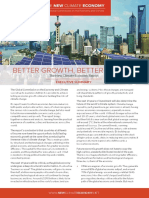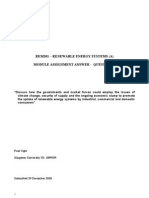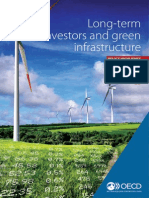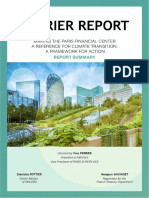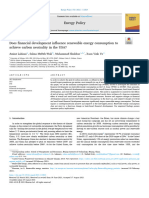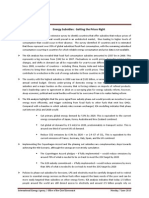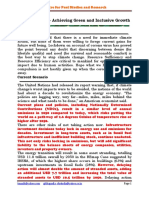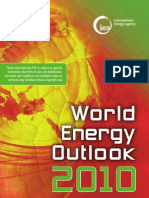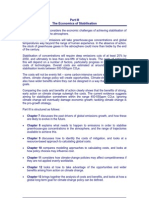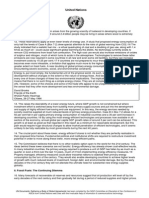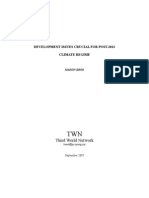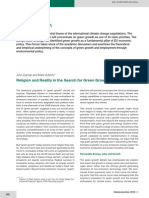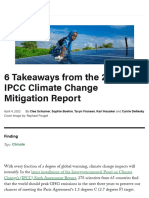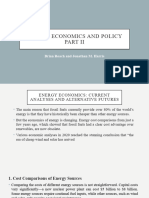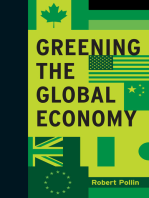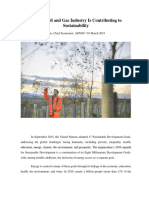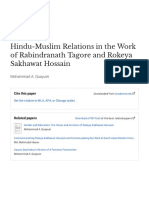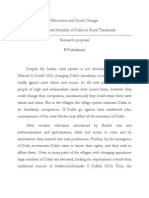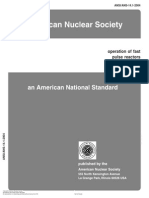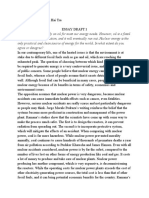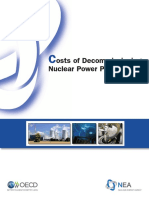Pollin - Industrial Policy Framework For Global Green New Deal
Pollin - Industrial Policy Framework For Global Green New Deal
Uploaded by
Aparajay SurnamelessCopyright:
Available Formats
Pollin - Industrial Policy Framework For Global Green New Deal
Pollin - Industrial Policy Framework For Global Green New Deal
Uploaded by
Aparajay SurnamelessOriginal Title
Copyright
Available Formats
Share this document
Did you find this document useful?
Is this content inappropriate?
Copyright:
Available Formats
Pollin - Industrial Policy Framework For Global Green New Deal
Pollin - Industrial Policy Framework For Global Green New Deal
Uploaded by
Aparajay SurnamelessCopyright:
Available Formats
An Industrial Policy Framework to Advance a Global Green New Deal
An Industrial Policy Framework to Advance a Global
Green New Deal
Robert Pollin
The Oxford Handbook of Industrial Policy
Edited by Arkebe Oqubay, Christopher Cramer, Ha-Joon Chang, and Richard Kozul-Wright
Print Publication Date: Oct 2020 Subject: Economics and Finance, Industrial Organization
Online Publication Date: Nov 2020 DOI: 10.1093/oxfordhb/9780198862420.013.16
Abstract and Keywords
This chapter argues that, as an analytic proposition and industrial policy challenge, it is
realistic that global CO2 emissions can be driven to net zero by 2050, the goal set in 2018
by the IPCC. This will require an average level of investment spending of about 2.5 per
cent of global GDP per year, focused in two areas: (1) dramatically improving energy-effi
ciency standards in the stock of buildings, automobiles and public transportation sys
tems, and industrial production processes; and (2) equally dramatically expanding the
supply of clean renewable energy sources—primarily solar and wind power—available at
competitive prices to all sectors and in all regions of the globe. The chapter examines the
industrial and financial policy measures that will be needed to support this global clean
energy investment project, focusing on approaches that have been implemented through
out the world to varying degrees.
Keywords: global clean energy investments, industrial/financial policies, net-zero goal, energy efficiency, solar and
wind power
15.1 Introduction
IN October 2018, the Intergovernmental Panel on Climate Change (IPCC), the most au
thoritative global organization advancing climate-change research, issued an alarming re
port titled Global Warming of 1.5°. This report emphasized the imperative of limiting the
increase in global mean temperatures to 1.5 degrees above pre-industrial levels as op
posed to the previous consensus target 2.0 degrees. The IPCC concluded that limiting the
global mean temperature increase to 1.5 rather than 2.0 degrees by 2100 will dramatical
ly lower the likely negative consequences of climate change. These include the risks of
heat extremes, heavy precipitation, droughts, sea level rise, biodiversity losses, and cor
responding impacts on health, livelihoods, food security, water supply, and human securi
ty.
Page 1 of 44
PRINTED FROM OXFORD HANDBOOKS ONLINE (www.oxfordhandbooks.com). © Oxford University Press, 2018. All Rights
Reserved. Under the terms of the licence agreement, an individual user may print out a PDF of a single chapter of a title in
Oxford Handbooks Online for personal use (for details see Privacy Policy and Legal Notice).
Subscriber: OUP-Reference Gratis Access; date: 10 November 2020
An Industrial Policy Framework to Advance a Global Green New Deal
The IPCC estimates that to achieve the 1.5 degrees maximum global mean temperature
increase target as of 2100, global net CO2 emissions will have to fall by about 45 per cent
as of 2030 and reach net-zero emissions by 2050. I focus in this chapter on what it will
take for the global economy to reach net-zero CO2 emissions by 2050, and specifically, in
terms of the industrial and financing policies that will be needed for this project to suc
ceed. In the interests of space, I do not delve into the additional specific challenges
around also hitting the IPCC’s intermediate target of a 45 per cent CO2 emissions reduc
tion by 2030, though important additional challenges do emerge with achieving this 2030
goal.
In fact, purely as an analytic proposition and policy challenge—independent of the
(p. 395)
myriad of political and economic forces arrayed around these matters—it is entirely real
istic to allow that global CO2 emissions can be driven to net zero by 2050. By my higher-
end estimate, it will require an average level of investment spending throughout the glob
al economy of about 2.5 per cent of global GDP per year, focused in two areas: 1) dramati
cally improving energy-efficiency standards in the stock of buildings, automobiles and
public transportation systems, and industrial production processes; and 2) equally dra
matically expanding the supply of clean renewable energy sources—primarily solar and
wind power—available at competitive prices to all sectors and in all regions of the globe.
This level of clean energy investment spending would amount to about $2.6 trillion1 in the
first year of the programme, which I will set as 2024 and rise to an average of about $4.5
trillion per year between 2024 and 2050. This assumes that the project actually begins in
2021, but that the full-scale expansion in clean energy investments requires a three-year
lead time. Thus the start date for the full-scale programme becomes 2024. Total clean en
ergy investment spending for the full-scale twenty-seven-year investment cycle 2024–50
would amount to about $120 trillion.
These figures are for overall investment spending, including from both the public and pri
vate sectors. Establishing the right mix between public and private investment will be a
major consideration within the industrial and financing policies framework. As an initial
rough approximation, I assume that the breakdown should be divided equally—that is, 50
per cent public and private investment. For the first year of full-scale investment activity
in 2024, this would break down to $1.3 trillion in both public and private investments. A
major part of the policy challenge will be to determine how to leverage the public money
most effectively to create strong incentives for private investors.
It is important to emphasize at the outset that this clean energy investment project will
pay for itself in full over time. More specifically, it will deliver lower energy costs for ener
gy consumers in all regions of the world. This results because raising energy-efficiency
standards means that, by definition, consumers will spend less for a given amount of en
ergy services, such as being able to travel 100 miles on a gallon of petrol with a high-effi
ciency hybrid plug-in vehicle as opposed to 25 miles per gallon with the average car on
US roads today. Moreover, the costs of supplying energy through solar and wind power,
as well as geothermal and hydro, are now, on average, roughly equal to or lower than
Page 2 of 44
PRINTED FROM OXFORD HANDBOOKS ONLINE (www.oxfordhandbooks.com). © Oxford University Press, 2018. All Rights
Reserved. Under the terms of the licence agreement, an individual user may print out a PDF of a single chapter of a title in
Oxford Handbooks Online for personal use (for details see Privacy Policy and Legal Notice).
Subscriber: OUP-Reference Gratis Access; date: 10 November 2020
An Industrial Policy Framework to Advance a Global Green New Deal
those for fossil fuels and nuclear energy. As such, the initial upfront investment outlays
can be repaid over time through the cost savings that will be forthcoming.
For 2018, global clean energy investments levels, including both energy efficiency and
clean renewable investments, were at about $570 billion, equal to about 0.7 per cent of
global GDP. Thus, the increase in clean energy investments will need to be in the range of
1.8 per cent of global GDP—that is, about $1.5 trillion at the current global GDP level of
about $86 trillion, then rising in step with global GDP growth thereafter (p. 396) until
2050. The consumption of oil, coal, and natural gas will also need to fall to zero over this
same thirty-year period. The rate of decline can begin at a relatively modest 3.5 per cent
in the initial years of the transition programme, but will then increase every year in per
centage terms, as the base level of fossil-fuel supply contracts to zero as of 2050.
Of course, both the privately owned fossil-fuel companies, such as Exxon-Mobil and
Chevron, and equally, the publicly owned companies such as Saudi Aramco and Gazprom
in Russia, have massive self-interests at stake in preventing reductions in fossil-fuel con
sumption as well as enormous political power. These powerful vested interests will simply
have to be defeated. How exactly this is accomplished is beyond the scope of this chapter,
other than to recognize that a critical foundation for advancing a successful global Green
New Deal will be to establish a viable set of industrial and financing policies to support
the project.
The structure of this chapter is as follows. Section 15.2 asks the first critical question for
designing a global clean energy investment project, which is: what is clean energy? I re
view evidence on natural gas, nuclear energy, and various forms of geoengineering as
providing clean energy alternatives to fossil fuels. But I conclude that all these approach
es present major problems. This conclusion then becomes the basis for recognizing that
building a global clean energy economy should rely mostly on dramatically expanding in
vestments in energy efficiency and clean renewable energy sources.
In considering the prospects for achieving major gains in energy efficiency, I introduce
the concept of ‘energy intensity ratios’ and review evidence on this ratio for the global
economy as well as for seven representative national economies, that is, China, the Unit
ed States, Brazil, Germany, Indonesia, South Africa, and South Korea. I will also focus on
Brazil, Germany, Indonesia, South Africa, and South Korea later in this study.
With respect to ‘clean renewable energy sources’, as I use the term, it excludes many
forms of bioenergy, such as ethanol from corn or sugarcane using conventional refining
methods. This is because, considered over a thirty-year life cycle, the emissions generat
ed from these energy sources are comparable to those from fossil fuels.2 The clean re
newable sources on which I focus in section 15.2 and throughout the study are solar and
wind power, as well as, to a more modest extent, geothermal and hydro power, as well as
bioenergy generated through low-emissions technologies.
Page 3 of 44
PRINTED FROM OXFORD HANDBOOKS ONLINE (www.oxfordhandbooks.com). © Oxford University Press, 2018. All Rights
Reserved. Under the terms of the licence agreement, an individual user may print out a PDF of a single chapter of a title in
Oxford Handbooks Online for personal use (for details see Privacy Policy and Legal Notice).
Subscriber: OUP-Reference Gratis Access; date: 10 November 2020
An Industrial Policy Framework to Advance a Global Green New Deal
Section 15.3 presents a simple model through which I calculate the investment require
ments for creating a global net-zero-emissions economy as of 2050. I show through this
model that investments in energy efficiency and clean renewable energy at an average
2.5 per cent share of global GDP per year will be sufficient for achieving this end. The
model builds from the assumption of the most recent global energy model of the Interna
tional Energy Agency (IEA), which assumes that global GDP grows at an average annual
rate of 3.4 per cent per year over 2021–40.
Section 15.4 then considers the industrial and financial policy measures that will be need
ed to support this global clean energy investment project. I examine a range of (p. 397)
policy approaches that have been implemented throughout the world to varying degrees.
I also propose specific sources of funding that are capable of bringing total clean energy
investments to $2.6 trillion as of 2024—that is, 2.5 per cent of global GDP in 2024—along
with the capacity to increase funding at a rate corresponding with global GDP through
2050.
In section 15.5, I consider the domestic resource capacities in various countries to sup
port its clean energy transformation, focusing, again, on Brazil, Germany, Indonesia,
South Africa, and South Korea. To the extent that a country runs up against domestic pro
ductive capacity constraints while expanding its investments in energy efficiency and
clean renewable energy, it then must either scale back the clean energy investment
project or rely increasingly on imports to maintain the ambitious investment agenda. For
the five representative economies, I show how this domestic resource constraint will be
manageable.
One factor that will be important in enabling the expansion of domestic production in
clean energy will be the fact that the fossil-fuel sectors in all countries will be correspond
ingly contracting. Thus, in section 15.6, I show how the freeing up of economic resources
out of the activities tied to the fossil-fuel sector will be substantial in all cases, including
countries such as Germany and South Korea, which are presently dependent on imports
as their source of fossil-fuel energy.
In the concluding section 15.7, I briefly summarize the full set of findings in sections 15.2
–15.6. These findings demonstrate how a global clean energy project—that is, a Global
Green New Deal, as I understand the term—does indeed provide a viable path for achiev
ing a net-zero-emissions global economy as of 2050. I also show that the industrial and fi
nancial policy tools needed to deliver on this project are well understood and have been
well tested in various parts of the world, under a range of circumstances. These policy
tools now need to be implemented on a scale appropriate to the magnitude of the chal
lenge we now face with climate change.
This chapter covers a large number of issues within a relatively brief amount of space. At
the same time, due to space limitations, it does not cover several topics that are also criti
cal for understanding the full scope of industrial policy requirements for implementing a
successful global Green New Deal. One such critical set of issues covers the employment
impacts of the global clean energy investment project, which, in turn, breaks down into
Page 4 of 44
PRINTED FROM OXFORD HANDBOOKS ONLINE (www.oxfordhandbooks.com). © Oxford University Press, 2018. All Rights
Reserved. Under the terms of the licence agreement, an individual user may print out a PDF of a single chapter of a title in
Oxford Handbooks Online for personal use (for details see Privacy Policy and Legal Notice).
Subscriber: OUP-Reference Gratis Access; date: 10 November 2020
An Industrial Policy Framework to Advance a Global Green New Deal
two components. The first is assessing the large employment creation opportunities that
will be generated through investing 2.5 per cent of GDP in clean energy projects in all re
gions of the world. The second is recognizing the job losses that will result through the
contraction of the global fossil-fuel industry, and the imperative of establishing a set of
just transition policies for both the workers and communities that will be negatively im
pacted as a result. I have addressed these issues at length elsewhere and will continue to
do so in future research.3
Related to this is the large set of questions on the developmental impact of the
(p. 398)
clean energy transition on economies that are presently net fossil-fuel exporters. These
questions are linked to the broader literature around the so-called ‘resource curse’. These
issues, again, lie beyond the scope of this chapter, even while the relevant literature is
quite extensive.4
Another set of critical issues that I have not been able to address here are the land use
requirements for building a global clean energy infrastructure. The work of the physicist
Mara Prentiss demonstrates that, in fact, through well-designed policies, these land-use
requirements will be relatively modest. But the overall global Green New Deal project will
benefit through developing with greater specificity the framework that Prentiss has de
veloped.5
15.2 What is Clean Energy?
15.2.1 Natural Gas
There are large differences in the emissions levels resulting through burning oil, coal,
and natural gas, with natural gas generating about 40 per cent fewer emissions for a giv
en amount of energy produced than coal and 15 per cent less than oil. It is therefore
widely argued that natural gas can be a ‘bridge fuel’ to a clean energy future, through
switching from coal to natural gas to produce electricity.6 Such claims do not withstand
scrutiny. At best, an implausibly large 50 per cent global fuel switch to natural gas would
reduce CO2 emissions by only 8 per cent. But even this calculation does not take account
of the leakage of methane gas into the atmosphere that results through extracting natural
gas through fracking. Recent research finds that when more than about 5 per cent of the
gas extracted leaks into the atmosphere through fracking, the impact eliminates any envi
ronmental benefit from burning natural gas relative to coal. Various studies have report
ed a wide range of estimates as to what leakage rates have actually been in the United
States, at fracking operations have grown rapidly. A recent survey paper puts that range
at between 0.18 and 11.7 per cent for different specific sites in North Dakota, Utah, Col
orado, Louisiana, Texas, Arkansas, and Pennsylvania.
It would be reasonable to assume that if fracking expands on a large scale in regions out
side the United States, it is likely that leakage rates will fall closer to the higher-end fig
ures of 12 per cent, at least until serious controls could be established. This then (p. 399)
Page 5 of 44
PRINTED FROM OXFORD HANDBOOKS ONLINE (www.oxfordhandbooks.com). © Oxford University Press, 2018. All Rights
Reserved. Under the terms of the licence agreement, an individual user may print out a PDF of a single chapter of a title in
Oxford Handbooks Online for personal use (for details see Privacy Policy and Legal Notice).
Subscriber: OUP-Reference Gratis Access; date: 10 November 2020
An Industrial Policy Framework to Advance a Global Green New Deal
would greatly diminish, if not eliminate altogether, any emission-reduction benefits from a
coal-to-natural-gas fuel switch.7
15.2.2 Nuclear Energy
As of 2018, nuclear power provided 28 quadrillion British Thermal Units (Q-BTUs) of en
ergy throughout the global economy, amounting to 5 per cent of total global supply. Near
ly 90 per cent of global nuclear power supply is generated in North America, Europe, Chi
na, and India. In terms of the world reaching a net-zero CO2 emissions target by 2050, nu
clear power provides the important benefit that it does not generate CO2 emissions or air
pollution of any kind while operating. At the same time, the processes for mining and re
fining uranium ore, making reactor fuel, and building nuclear power plants all require
large amounts of energy.
But even if we put aside the emissions that result from building and operating nuclear
power plants, we still need to recognize the long-standing environment and public safety
issues associated with nuclear energy. These include:
• Radioactive wastes. These wastes include uranium mill tailings, spent reactor fuel,
and other wastes, which according to the US Energy Information Agency (EIA) ‘can re
main radioactive and dangerous to human health for thousands of years’ (EIA, 2012:
1).
• Storage of spent reactor fuel and power plant decommissioning. Spent reactor fuel
assemblies are highly radioactive and must be stored in specially designed pools or
specially designed storage containers. When a nuclear power plant stops operating,
the decommissioning process involves safely removing the plant from service and re
ducing radioactivity to a level that permits other uses of the property.
• Political security. Nuclear energy can obviously be used to produce deadly weapons
as well as electricity. Thus, the proliferation of nuclear energy production capacity cre
ates dangers of this capacity being acquired by organizations—governments or other
wise—which would use that energy as instruments of war or terror.
• Nuclear reactor meltdowns. An uncontrolled nuclear reaction at a nuclear plant can
result in widespread contamination of air and water with radioactivity for hundreds of
miles around a reactor.
Even while recognizing these problems with nuclear energy, it is still the case, as noted
above, that nuclear power presently supplies over 5 per cent of global energy supply. For
decades, the prevalent view throughout the world was that these risks associated with
nuclear power were relatively small and manageable, when balanced against its benefits.
However, this view was upended in the aftermath of the March 2011 (p. 400) nuclear melt
down at the Fukushima Daiichi power plant in Japan, which resulted from the massive 9.0
Tohuku earthquake and tsunami. The full effects of the Fukushima meltdown cannot pos
sibly be known for some time. Still, these safety considerations with nuclear energy must
be accorded significant weight. This is especially the case, given the high probability that
Page 6 of 44
PRINTED FROM OXFORD HANDBOOKS ONLINE (www.oxfordhandbooks.com). © Oxford University Press, 2018. All Rights
Reserved. Under the terms of the licence agreement, an individual user may print out a PDF of a single chapter of a title in
Oxford Handbooks Online for personal use (for details see Privacy Policy and Legal Notice).
Subscriber: OUP-Reference Gratis Access; date: 10 November 2020
An Industrial Policy Framework to Advance a Global Green New Deal
the necessary tight standards for regulating nuclear power plants will become compro
mised if the number of such plants were to expand significantly on a global scale. As
such, nuclear energy cannot be seen as providing a major reliable long-term source of
non-carbon-emitting energy supplies.
15.2.3 Geoengineering
This includes a broad category of measures whose purpose is either to remove existing
CO2 or to inject cooling forces into the atmosphere to counteract the warming effects of
CO2 and other greenhouse gases. One broad category of removal technologies is carbon
capture and sequestration (CCS). A category of cooling technologies is stratospheric
aerosol injections (SAI).
CCS technologies aim to capture emitted carbon and transport it, usually through
pipelines, to subsurface geological formations, where it would be stored permanently.
One straightforward and natural variation on CCS is afforestation. This involves increas
ing forest cover or density in previously non-forested or deforested areas, with ‘reforesta
tion’—the more commonly used term—as one component.
The general class of CCS technologies has not been proven at a commercial scale, despite
decades of efforts to accomplish this. A major problem with most CCS technologies is the
prospect for carbon leakages that would result under flawed transportation and storage
systems. These dangers will only increase to the extent that CCS technologies are com
mercialized and operating under an incentive structure in which maintaining safety stan
dards will reduce profits. By contrast, afforestation is, of course, a natural and proven
carbon removal technology. At the same time, most deforestation projects throughout the
globe were undertaken to make space for raising crops and livestock. Relying heavily on
afforestation as a climate change strategy would therefore likely present serious land-use
competition problems.
The idea of stratospheric aerosol injections builds from the results that followed from the
volcanic eruption of Mount Pinatobo in the Philippines in 1991. The eruption led to a mas
sive injection of ash and gas, which produced sulphate particles, or aerosols, which then
rose into the stratosphere. The impact was to cool the earth’s average temperature by
about 0.6°C for fifteen months.8 The technologies being researched now aim to artificially
replicate the impact of the Mount Pinatubo eruption through deliberately injecting sul
phate particles into the stratosphere. Some researchers (p. 401) contend that to do so
would be a cost-effective method of counteracting the warming effects of greenhouse gas
es.
Lawrence et al. (2018) published an extensive review on the range of climate geoengi
neering technologies, including 201 literature references. Their overall conclusion from
this review is that none of these technologies are presently at a point at which they can
make a significant difference in reversing global warming. They conclude:
Page 7 of 44
PRINTED FROM OXFORD HANDBOOKS ONLINE (www.oxfordhandbooks.com). © Oxford University Press, 2018. All Rights
Reserved. Under the terms of the licence agreement, an individual user may print out a PDF of a single chapter of a title in
Oxford Handbooks Online for personal use (for details see Privacy Policy and Legal Notice).
Subscriber: OUP-Reference Gratis Access; date: 10 November 2020
An Industrial Policy Framework to Advance a Global Green New Deal
Proposed climate geoengineering techniques cannot be relied on to be able to
make significant contributions…towards counteracting climate change in the con
text of the Paris Agreement. Even if climate geoengineering techniques were ac
tively pursued, and eventually worked as envisioned on global scales, they would
very unlikely be implementable prior to the second half of the century…This would
very likely be too late to sufficiently counteract the warming due to increasing lev
els of CO2 and other climate forcers to stay within the 1.50C temperature limit—
and probably even the 2°C limit—especially if mitigation efforts after 2030 do not
substantially exceed the planned efforts of the next decade (2018: 13–14).9
15.2.4 Energy Efficiency and Clean Renewable Energy
Given these major problems with natural gas as a ‘bridge fuel’, nuclear energy, and geo
engineering, it follows that we focus instead on the most cautious clean energy transition
programme, that is, investing in technologies that are well understood, already operating
at large scale, and, without question, safe. In short, we focus on investments that can dra
matically raise energy-efficiency standards and equally dramatically expand the supply of
clean renewable energy sources.
15.2.5 Energy Efficiency
Energy efficiency entails using less energy to achieve the same, or even higher, levels of
energy services from the adoption of improved technologies and practices. Examples in
clude insulating buildings much more effectively to stabilize indoor temperatures; driving
more fuel-efficient cars or, better yet, relying increasingly on well-functioning public
transportation systems; and reducing the amount of energy that is wasted both through
generating and transmitting electricity and through operating industrial machinery.
Expanding energy-efficiency investments support rising living standards because raising
energy-efficiency standards, by definition, saves money for energy consumers. (p. 402) A
major 2010 study by the US National Academy of Sciences (NAS) found, for the US econ
omy, that ‘energy-efficient technologies…exist today, or are expected to be developed in
the normal course of business, that could potentially save 30 per cent of the energy used
in the US economy while also saving money’. Similarly, a 2010 McKinsey & Company
study, focused on developing countries, found that, using existing technologies only, ener
gy-efficiency investments could generate savings in energy costs in the range of 10 per
cent of total GDP for all low- and middle-income countries.
In her 2015 book, Energy Revolution: The Physics and Promise of Efficient Technology,
Mara Prentiss argues, further, that such estimates understate the realistic savings poten
tial of energy-efficiency investments. This is because, in generating energy by burning
fossil fuels, about two-thirds of the total energy available is wasted while only one-third is
available for powering machines. By switching to renewable energy sources, the share of
wasted energy falls by 50 per cent. This is what Prentiss terms the ‘burning bonus’.
Page 8 of 44
PRINTED FROM OXFORD HANDBOOKS ONLINE (www.oxfordhandbooks.com). © Oxford University Press, 2018. All Rights
Reserved. Under the terms of the licence agreement, an individual user may print out a PDF of a single chapter of a title in
Oxford Handbooks Online for personal use (for details see Privacy Policy and Legal Notice).
Subscriber: OUP-Reference Gratis Access; date: 10 November 2020
An Industrial Policy Framework to Advance a Global Green New Deal
After taking account of the burning bonus as well as the efficiency gains available in the
operations of buildings, transportation systems, and industrial equipment, Prentiss con
cludes, with respect to the US economy specifically, that economic growth could proceed
at a normal rate while total energy consumption could remain constant or even decline in
absolute terms. Prentiss’s conclusions regarding the US economy are consistent with the
most recent projections for global energy demand by the International Energy Agency
(IEA, 2019). As I discuss further in section 15.3.1, the IEA assumes that the global econo
my will grow at a 3.4 per cent average annual rate between 2018 and 2040. Neverthe
less, under their most conservative Current Policies Scenario, the IEA assumes that glob
al energy consumption will grow at a much slower 1.3 per cent per year. Under their
more ambitious Sustainable Development Scenario, they assume that global energy con
sumption will actually fall at an average rate of –0.3 per cent per year, while economic
growth still proceeds at a 3.4 per cent average rate.10
A useful way to measure the relationship between the level of economic activity and the
energy resources consumed to support that activity is the energy intensity ratio. The en
ergy intensity ratio is, straightforwardly, the level of total energy resources consumed in
any given economy divided by the economy’s GDP. I report in Table A15.1 (in the Appen
dix) below the most recent energy intensity figures for the world economy as well as for
seven representative large economies—China, the United States, Brazil, Germany, In
donesia, South Africa, and South Korea.
In section 15.2.6, I will focus on this ratio for the world economy as a key variable for es
timating the costs of reaching a zero CO2 emissions global economy by 2050. For now, it
will be useful to consider the patterns for the global economy and the respective national
economies. The units in which I measure the ratio are Q-BTUs of energy consumed/tril
lion dollars of GDP. As the table shows, the intensity ratio, as of 2018, was 6.6 Q-BTUs for
every $1 trillion of global GDP. With the individual country (p. 403) figures, we see that the
intensity ratios vary widely by country. Germany is the most efficienct economy, with the
lowest 3.5 intensity ratio. The United States is next, at with a 5.3 intensity ratio, following
by Brazil at 7.2. South Korea and Indonesia are at similar efficiency levels, with 9.3 and
9.8 intensity ratios respectively. China is operating at a relatively low efficiency level,
with a 12.7 intensity ratio. South Africa is the least energy efficient of the countries in our
sample, with an intensity ratio of 20.3.11
15.2.6 Estimating Costs of Efficiency Gains
This range of energy intensity figures notwithstanding, the aim of the clean energy in
vestment project will be to achieve dramatic improvements in efficiency in all national
economies across the global economy. The question we therefore need to address is: how
much will it cost to achieve such large-scale efficiency gains?
In fact, estimates as to the investment costs for achieving energy-efficiency gains vary
widely. In Table A15.2 in the Appendix, I show summary estimates from three sets of stud
ies. As we see, the 2008 World Bank study by Taylor et al. puts average costs at $1.9 bil
Page 9 of 44
PRINTED FROM OXFORD HANDBOOKS ONLINE (www.oxfordhandbooks.com). © Oxford University Press, 2018. All Rights
Reserved. Under the terms of the licence agreement, an individual user may print out a PDF of a single chapter of a title in
Oxford Handbooks Online for personal use (for details see Privacy Policy and Legal Notice).
Subscriber: OUP-Reference Gratis Access; date: 10 November 2020
An Industrial Policy Framework to Advance a Global Green New Deal
lion per Q-BTU of energy savings, based on a study of 455 projects in both industrial and
developing economies. A 2010 study by McKinsey estimates costs for a wide range of
non-OECD economies at $11 billion per Q-BTU of energy savings. Focusing just on the US
economy, NAS estimated average costs for energy-efficiency savings in the buildings and
industrial sectors at about $29 billion per Q-BTU.12
It is not surprising that average costs to raise energy-efficiency standards would be sig
nificantly higher in industrialized economies. A high proportion of overall energy-efficien
cy investments are labour costs, especially projects to retrofit buildings and industrial
equipment. However, these wide differences in cost estimates shown in Table A15.2 do
not simply result from variations in labour and other input costs by regions and levels of
development.
Thus, the World Bank estimate of $1.9 billion per Q-BTU includes both industrialized and
developing countries, while the McKinsey $11 billion per Q-BTU estimate—nearly six
times greater than the World Bank figure—is primarily coming from developing-country
projects. These alternative studies do not provide sufficiently (p. 404) detailed method
ological discussions that would enable us to identify the main factors generating these
major differences in cost estimates. But it is at least reasonable to conclude from these
figures that, with on-the-ground real-world projects, there are likely to be large variations
in costs down to the project-by-project level. Thus, the costs for energy-efficiency invest
ments that will apply in any given situation will necessarily be specific to that situation,
and must always be analysed on a case-by-case basis. At the same time, for our present
purposes, we need to proceed with some general rules of thumb for estimating the level
of savings that is attainable through a typical set of efficiency projects in various regions
of the world, and more precisely an aggregated estimate for the global economy.
A conservative approach will be to allow that, relative to the World Bank and US National
Academy of Sciences figures, the mid-range cost estimate provided by McKinsey at $11
billion per Q-BTU of savings, is appropriate for low- and middle-income economies, such
as Brazil, Indonesia, and South Africa. Along the same lines, we could assume that the
cost figure for Germany will be equivalent to what the NAS study estimated for the Unit
ed States, at around $30 billion per Q-BTU of savings. The South Korean economy would
then be an approximate midpoint between those two other figures, at around $20 billion
per Q-BTU. As a working approximation for the global economy, this same midpoint figure
of $20 billion per Q-BTU of savings should be a credible high-end estimate, especially
while recognizing that the World Bank estimate for 455 projects in both developing and
advanced economies is ten times higher, at about $2 billion per Q-BTU of savings.
15.2.7 Rebound Effects
Raising energy-efficiency levels will generate ‘rebound effects’—i.e. energy consumption
increases resulting from lower energy costs. But such rebound effects are likely to be
modest within the current context of a global project focused on reducing CO2 emissions
and stabilizing the climate. Among other factors, energy consumption levels in advanced
Page 10 of 44
PRINTED FROM OXFORD HANDBOOKS ONLINE (www.oxfordhandbooks.com). © Oxford University Press, 2018. All Rights
Reserved. Under the terms of the licence agreement, an individual user may print out a PDF of a single chapter of a title in
Oxford Handbooks Online for personal use (for details see Privacy Policy and Legal Notice).
Subscriber: OUP-Reference Gratis Access; date: 10 November 2020
An Industrial Policy Framework to Advance a Global Green New Deal
economies are close to saturation points in the use of home appliances and lighting—that
is, we are not likely to clean dishes much more frequently because we have a more effi
cient dishwasher. The evidence shows that consumers in advanced economies are likely
to heat and cool their homes as well as drive their cars more when they have access to
more efficient equipment. But these increased consumption levels are usually modest. Av
erage rebound effects are likely to be significantly larger in developing economies.13
But it is critical that all energy-efficiency gains will be accompanied by complimentary
policies (as discussed in section 15.4.1), including setting a price on carbon emissions to
discourage fossil-fuel consumption. Most significantly, expanding the (p. 405) supply of
clean renewable energy will allow for higher levels of energy consumption without lead
ing to increases in CO2 emissions. It is important to recognize, finally, that different coun
tries presently operate at widely varying levels of energy efficiency. For example, as we
saw in Table A15.1, Germany presently operates at an efficiency level roughly 50 per cent
higher than that of the United States. Brazil is at an efficiency level that is nearly three
times that of South Africa. There is no evidence that large rebound effects have emerged
as a result of these high efficiency standards in Germany and Brazil relative to those of
the United States and South Africa.
15.2.8 Renewable Energy
A critical point for building a net-zero global economy by 2050 is the fact that, on aver
age, the costs of generating electricity with clean renewable energy sources are now at
parity or lower than those for fossil-fuel-based electricity. Table A15.3 in the Appendix
shows the most recent figures reported by the International Renewable Energy Agency
(IRENA), for 2010 and 2017, on the ‘levellized costs’ of supplying electricity through al
ternative energy sources. Levellized costs takes account of all costs of producing and de
livering a kilowatt of electricity to a final consumer. The cost calculations begin with the
upfront capital expenditures needed to build the generating capacity, continue through to
the transmission and delivery of electricity, and include the costs of energy that is lost
during the electricity-generation process.
As we see in Table A15.3, the levellized costs for fossil-fuel-generated electricity range be
tween 4.5 and 14 cents per kilowatt hour as of 2017. The average figures for the four
clean renewable sources are all within this range for fossil fuels as of 2017, with hydro at
5 cents, onshore wind at 6 cents, geothermal at 7 cents and solar PV at 10 cents. The
costs of geothermal and hydro did not fall, and actually rose modestly, between 2010 and
2017. However, the costs of onshore wind fell by 25 per cent, from 8 to 6 cents. The most
impressive result though is with solar PV, in which levellized costs fell by 72 per cent
from 2010 to 2017, from 36 cents to 10 cents per kilowatt hour. These average cost fig
ures for solar and wind should continue to decline by significant amounts as advances in
technology and economies of scale proceed along with the rapid global expansion of these
sectors.
Page 11 of 44
PRINTED FROM OXFORD HANDBOOKS ONLINE (www.oxfordhandbooks.com). © Oxford University Press, 2018. All Rights
Reserved. Under the terms of the licence agreement, an individual user may print out a PDF of a single chapter of a title in
Oxford Handbooks Online for personal use (for details see Privacy Policy and Legal Notice).
Subscriber: OUP-Reference Gratis Access; date: 10 November 2020
An Industrial Policy Framework to Advance a Global Green New Deal
We emphasize that these cost figures from the IRENA are simple averages. They do not
show differences in costs due to regional or seasonally specific factors.14 In particular, so
lar and wind energy costs will vary significantly by region and season. Moreover, both
wind and solar energy are intermittent sources—that is, they only generate energy, re
spectively, when the sun is shining or the wind is blowing. Of course, the central role of
energy storage systems to address these matters will need to be fully (p. 406) accounted
for when clean renewable energy systems are designed to provide a major share of an
economy’s overall energy load.15
Keeping all such considerations in mind, we can still roughly conclude from these figures
that, for the most part, clean renewable energy sources are rapidly emerging into a posi
tion at which they can produce electricity at comparable or lower costs than non-renew
able sources. As such, assuming that wind, solar, and geothermal energy production can
be scaled up to meet virtually all global demand by 2050, then the costs to consumers of
purchasing this energy should not be significantly different from what these consumers
would have paid for non-renewable energy. Indeed, overall, the costs to consumers of pur
chasing electricity from clean renewable sources, including hydro as well as wind, solar,
and geothermal power, are likely to be lower than what they would be from fossil-fuel
sources. It is critical to also emphasize that this is without factoring in the environmental
costs of burning oil, coal, and natural gas.
15.2.9 Costs of Expanding Renewable Capacity
By a substantial amount, the largest share of overall costs in generating electricity from
renewable sources are capital costs—that is, the costs of producing new productive
equipment, as opposed to the costs of operating that productive equipment once it has
been built and is generating energy. These capital costs are at about 65 per cent of total
costs for geothermal, 73 per cent for onshore wind, and 81 per cent for solar PV.16 From
these figures on levellized costs, we can also estimate the capital costs of installing re
newable energy capacity as a lump sum—that is, how much investors need to spend up
front to put this capital equipment into place and in running order.
I produce estimates of these lump sum capital costs in Table A15.4 in the Appendix.
Specifically, these figures represent the present values of total lump-sum capital expendi
tures needed to produce one Q-BTU of electricity from onshore wind, solar PV, and geot
hermal energy.17 As we see, the average lump-sum costs range from $112 billion per Q-
BTU for geothermal, $160 billion for onshore wind, and $190 billion for solar.
If we assume that, roughly speaking, the global expansion of clean renewable energy ca
pacity will consist of 45 per cent from wind and solar PV technologies, and 10 per cent
from geothermal energy, this would place the average costs of producing one Q-BTU of
overall renewable energy equipment at about $169 billion, which we can round up to
$170 billion per Q-BTU of clean renewable capacity. This $170 billion figure can therefore
serve as a benchmark for estimating the average costs of expanding the supply of clean
renewable energy on a global scale. At the same time, (p. 407) as with our cost estimate
Page 12 of 44
PRINTED FROM OXFORD HANDBOOKS ONLINE (www.oxfordhandbooks.com). © Oxford University Press, 2018. All Rights
Reserved. Under the terms of the licence agreement, an individual user may print out a PDF of a single chapter of a title in
Oxford Handbooks Online for personal use (for details see Privacy Policy and Legal Notice).
Subscriber: OUP-Reference Gratis Access; date: 10 November 2020
An Industrial Policy Framework to Advance a Global Green New Deal
for investments in energy efficiency, we will want to err, if anything, on the side of overes
timating, rather than underestimating, the costs of expanding clean renewable energy.
Moreover, with the expansion of the globe’s clean energy supply proceeding rapidly over
2024–50, the average costs are likely to rise as production bottlenecks emerge. We there
fore will assume that the average costs of expanding the clean energy supply will be $200
billion per Q-BTU, that is, about 18 per cent higher than the $170 billion average figure
we have derived from the levellized costs data.
We can now work with our two rough high-end estimates of the overall costs of both rais
ing energy-efficiency standards and building new clean renewable energy capacity—$20
billion per Q-BTU for efficiency gains and $200 billion per Q-BTU for expanding renew
able capacity—to generate an estimate of the total costs of achieving a net-zero global
economy by 2050.
15.3 Economic Growth and Emissions Reduc
tions
In this section, I present a simple model to illustrate how the global economy can achieve
net-zero CO2 emissions by 2050 through investing about 2.5 per cent of global GDP per
year to raise energy-efficiency standards and to expand the supply of clean renewable en
ergy sources. The model works from the following assumptions:
1. Average costs for increasing energy efficiency and expanding clean renewable
production. As discussed, I assume that the average costs to increase energy efficien
cy by 1 Q-BTU will be $20 billion. I also assume that the average costs to expand pro
ductive capacity of clean renewable energy by 1 Q-BTU will be $200 billion.
2. Global GDP growth trend. The IEA’s forecast assumes an average global GDP
growth rate of 3.4 per cent between 2018 and 2040 (2019: 753). My model incorpo
rates this figure. To date, the IEA has not published a global GDP growth forecast
that extends beyond 2040. For the purposes of the current exercise, I assume that
the 3.4 per cent average global GDP growth rate will extend to 2050.
3. Clean renewable energy sources supply 100 per cent of global energy demand. As
discussed, there may be a case for relying to a limited extent on nuclear energy and
some types of carbon capture technologies beyond afforestation as a supplement to
clean renewable sources. But this model demonstrates how, as of 2050, it will be cost
effective as well as technically feasible to deliver 100 per cent of global energy sup
ply through clean renewables.
4. Three-year delay in bringing the project to scale. This is a thirty-year investment
project. But given that the current level of clean energy investments is in the range
(p. 408) of 0.7 per cent of global GDP,18 we must realistically allow for some incuba
tion time to pass before we can expect investments to rise by 1.8 percentage points
as a share of GDP, to a 2.5 per cent of annual GDP level. To reflect this consideration,
I assume, as noted above, that it will require three years of major initiatives within
the realms of industrial policy and financing to raise global clean energy investments
Page 13 of 44
PRINTED FROM OXFORD HANDBOOKS ONLINE (www.oxfordhandbooks.com). © Oxford University Press, 2018. All Rights
Reserved. Under the terms of the licence agreement, an individual user may print out a PDF of a single chapter of a title in
Oxford Handbooks Online for personal use (for details see Privacy Policy and Legal Notice).
Subscriber: OUP-Reference Gratis Access; date: 10 November 2020
An Industrial Policy Framework to Advance a Global Green New Deal
by roughly 1.8 per cent of GDP relative to current investment levels. We therefore as
sume that the 2.5 per cent of GDP per year level of clean energy investments will oc
cur over twenty-seven years within the full thirty-year investment cycle, that is, be
tween 2024 and 2050. The initial three years of the model, 2021–3, will be needed to
develop an adequate industrial policy and financing environment to sustain clean en
ergy investments at this level.
The results of this model are presented in Tables 15.1–15.4.
15.3.1 Global Model Framework and Calculations
In Table 15.1, we start with the actual global GDP figure in 2018 of $86 trillion.19 We then
work with the IEA’s assumption of average global GDP growth over the subsequent thirty
years at 3.4 per cent per year. From our initial 2018 GDP figure of $86 trillion and our as
sumption of 3.4 per cent average annual growth, we can then estimate the level of GDP
every year through 2050. Under these assumptions, global GDP will be $260 trillion in
2050. The model projects global GDP in 2050 at $260 trillion. We can also then calculate
the ‘midpoint’ GDP figure over the 2021–50 thirty-year investment cycle. I define this
midpoint figure as being equal to the average of the estimates of GDP in 2021 and 2050,
assuming average annual GDP growth at 3.4 per cent. This midpoint figure, as we see, is
$178 trillion. From this midpoint figure, we can then readily calculate a ratio for average
annual clean renewable investments.
Page 14 of 44
PRINTED FROM OXFORD HANDBOOKS ONLINE (www.oxfordhandbooks.com). © Oxford University Press, 2018. All Rights
Reserved. Under the terms of the licence agreement, an individual user may print out a PDF of a single chapter of a title in
Oxford Handbooks Online for personal use (for details see Privacy Policy and Legal Notice).
Subscriber: OUP-Reference Gratis Access; date: 10 November 2020
An Industrial Policy Framework to Advance a Global Green New Deal
Table 15.1 Thirty-year global GDP growth trajectory, 2021–50
2018 global GDP $86 tril
lion
Projected average annual GDP growth rate through 3.4%
2040 (from IEA, 2019: 753)
Projected 2021 GDP (with 3.4% average annual GDP $95 tril
growth) lion
Projected 2024 GDP (First year of 27-year investment $104 tril
cycle; with 3.4% average annual GDP growth) lion
Projected 2050 GDP (with 3.4% average annual GDP $260 tril
growth) lion
Midpoint GDP value for investment spending estimates $178 tril
(= (2021 GDP + 2050 GDP)/2) lion
Sources: World Development Indicators; International Energy Agency,
World Energy Outlook, 2019.
In Table 15.1, I estimate the level of clean energy investments necessary to bring the av
erage global energy intensity ratio down from its current level of 6.6 (Q-BTUs/ (p. 409) tril
lion dollars of GDP) to 2.0, a 70 per cent improvement in average global energy efficien
cy. The 2.0 energy intensity ratio is the figure projected by the IEA in its 2019 Sustain
able Development Scenario. This will be while, according to the IEA model, average glob
al GDP is growing at 3.4 per cent per year.
Page 15 of 44
PRINTED FROM OXFORD HANDBOOKS ONLINE (www.oxfordhandbooks.com). © Oxford University Press, 2018. All Rights
Reserved. Under the terms of the licence agreement, an individual user may print out a PDF of a single chapter of a title in
Oxford Handbooks Online for personal use (for details see Privacy Policy and Legal Notice).
Subscriber: OUP-Reference Gratis Access; date: 10 November 2020
An Industrial Policy Framework to Advance a Global Green New Deal
Table 15.2 Global energy demand and energy-efficiency cost projec
tions for 2050
A) Total energy demand through alternative scenarios
2050 En Average annu Average
ergy con al energy de 2050 global
sumption mand growth energy inten
rate sity ratio
2050 energy 1,716 Q- 3.4% 6.6
demand, with BTUs
constant ener
gy intensity ra
tio
2050 energy 512 Q- –0.3% 2.0
demand BTUs
through IEA
Sustainable De
velopment Sce
nario
B) Cost of achieving energy savings through the IEA sustain
able development scenario
1. Total energy savings through the IEA 1,204 Q-BTUs (= 1,716
Sustainable Development Scenario Q-BTUs – 512 Q-BTUs)
2. Average cost of energy savings $20 billion/Q-BTU
through efficiency investments
3. Total cost of energy savings through $24.1 trillion (= rows 2 x
efficiency investments 3)
4. Average annual cost of energy sav $891 billion ($24.1 tril
ings through efficiency investments lion/27 years)
Notes: Actual 2018 global energy consumption = 568 Q-BTUs; global
energy intensity ratio = 6.6.
Source: IEA (2019: 678).
Page 16 of 44
PRINTED FROM OXFORD HANDBOOKS ONLINE (www.oxfordhandbooks.com). © Oxford University Press, 2018. All Rights
Reserved. Under the terms of the licence agreement, an individual user may print out a PDF of a single chapter of a title in
Oxford Handbooks Online for personal use (for details see Privacy Policy and Legal Notice).
Subscriber: OUP-Reference Gratis Access; date: 10 November 2020
An Industrial Policy Framework to Advance a Global Green New Deal
As section A of Table 15.2 shows, if the global economy continues to operate at its current
6.6 energy intensity ratio through 2050, global energy consumption will be at 1,716 Q-
BTUs in 2050. By contrast, if the global economy does succeed in driving down the ener
gy intensity ratio to 2.0 through efficiency investments, it follows that global energy con
sumption will be at 512 Q-BTUs as of 2050.
As we then see in section B of Table 15.2, total energy savings achieved through operat
ing the global economy at a 2.0 rather than a 6.6 average intensity ratio will be 1,204 Q-
BTUs. Since, as our high-end figure, we assume that the average global cost of achieving
efficiency gains is $20 billion per Q-BTU, this means that achieving 1,204 Q-BTUs in glob
al efficiency gains will cost a total of $24.1 trillion. As Panel B of Table 15.2 shows, the av
erage annual investment level of the twenty-seven-year investment period is therefore
$891 billion.
In Table 15.3, we work with the 2050 global energy consumption figure of 512 Q-BTUs
from Table 15.2 to calculate the investment requirements for meeting this level of total
energy demand through clean renewable sources. As the table shows, as of the most re
cent IEA figures, global supply of clean renewables is 26 Q-BTUs. This means that the ex
pansion of supply as of 2050 will need to be 486 Q-BTUs. It also means that the average
growth rate for expanding the global supply of clean renewable energy will need to be at
around 10 per cent per year for the full 2024–50 investment cycle.
Table 15.3 Global clean renewable energy expansion and cost projec
tion for 2050
1. Total 2050 energy consumption through the 512 Q-BTUs
Sustainable Development Scenario
2. 2018 clean renewable energy supply (from IEA, 26 Q-BTUs
2019: 678)
3. Net expansion of clean renewables as of 2050 486 Q-BTUs (=
row 1 – row 2)
4. Average cost of expanding clean renewable $200 billion/Q-
supply BTU
5. Total cost of expanding global clean renewable $97.2 trillion (=
supply by 486 Q-BTUs as of 2050 row 3 x row 4)
Average annual cost of expanding global clean re $3.6 trillion (=
newable supply by 286 Q-BTUs as of 2050 row 5/27)
Source: IEA (2019).
Page 17 of 44
PRINTED FROM OXFORD HANDBOOKS ONLINE (www.oxfordhandbooks.com). © Oxford University Press, 2018. All Rights
Reserved. Under the terms of the licence agreement, an individual user may print out a PDF of a single chapter of a title in
Oxford Handbooks Online for personal use (for details see Privacy Policy and Legal Notice).
Subscriber: OUP-Reference Gratis Access; date: 10 November 2020
An Industrial Policy Framework to Advance a Global Green New Deal
In terms of estimating the costs of this investment project, I then, again, assume a high-
end average cost figure for expanding global clean energy capacity, at $200 billion per Q-
BTU. Working from this figure, it follows, as shown in Table 15.3, that the total costs of
expanding global clean energy supply by 486 Q-BTUs as of 2050 will be $97.2 trillion. The
average annual costs over the twenty-seven-year investment cycle will therefore be $3.6
trillion.
In Table 15.4, I then summarize the figures for total and annual average costs for achiev
ing a net-zero global economy strictly on the basis of large-scale investments in (p. 410)
energy efficiency and clean renewables. As we see, total costs come to $121.3 trillion.
Over the twenty-seven-year investment cycle, this amounts to an average of $4.5 trillion
per year. Working from the estimates presented in Table 15.1, our figure for midpoint
global GDP between 2021 and 2050 is $178 trillion. This is how, finally, we are able to es
timate that the overall investment requirement for reaching a net-zero-emissions global
economy as of 2050 will amount, on average, to 2.5 per cent of global GDP per year.
Page 18 of 44
PRINTED FROM OXFORD HANDBOOKS ONLINE (www.oxfordhandbooks.com). © Oxford University Press, 2018. All Rights
Reserved. Under the terms of the licence agreement, an individual user may print out a PDF of a single chapter of a title in
Oxford Handbooks Online for personal use (for details see Privacy Policy and Legal Notice).
Subscriber: OUP-Reference Gratis Access; date: 10 November 2020
An Industrial Policy Framework to Advance a Global Green New Deal
Table 15.4 Costs of thirty-year clean energy investment project as
share of average GDP, 2021–50
Total costs of clean energy investments
1. Energy efficiency $24.1 tril
lion
2. Clean renewable energy $97.2 tril
lion
3. TOTAL (= rows 1 + 2) $121.3 tril
lion
2024 costs of clean energy investments (year 1 of 27-
year investment cycle)
4. Energy efficiency $500 billion
5. Clean renewable energy $2.1 trillion
6. TOTAL (= rows 5 + 6) $2.6 trillion
Average annual costs of clean energy investments
(27-year cycle)
7. Energy efficiency $891 billion/
year
8. Clean renewable energy $3.6 trillion/
year
9. TOTAL (= rows 7 + 8) $4.5 trillion/
year
Total costs of clean energy investments as share of
midpoint GDP
10. Midpoint GDP (from Table 15.1) $178 trillion
11. Clean energy investments as share of midpoint 2.5%
GDP (= row 6/row 7)
Page 19 of 44
PRINTED FROM OXFORD HANDBOOKS ONLINE (www.oxfordhandbooks.com). © Oxford University Press, 2018. All Rights
Reserved. Under the terms of the licence agreement, an individual user may print out a PDF of a single chapter of a title in
Oxford Handbooks Online for personal use (for details see Privacy Policy and Legal Notice).
Subscriber: OUP-Reference Gratis Access; date: 10 November 2020
An Industrial Policy Framework to Advance a Global Green New Deal
Source: IEA (2019).
15.4 Industrial and Financial Policies
15.4.1 Industrial Policies
Depending on specific conditions within each country, industrial policies will be needed to
promote technical innovations and, even more broadly, adaptations of existing clean ener
gy technologies. Again depending on circumstances, governments will need to deploy a
combination of industrial policy instruments, including research and development sup
port, preferential tax treatment for clean energy investments, and government procure
ment policies. Clean energy industrial policies will also need to include regulations of
both fossil-fuel and clean energy prices as well as emission standards.
One major policy intervention that can facilitate the creation of a vibrant clean energy
market will be for governments to themselves become both large-scale investors in ener
gy efficiency and purchasers of clean renewable energy. An important comparable histori
cal experience was the development of the Internet within the US military, beginning in
the 1940s. In the process of bringing the Internet to commercial scale, the US military
provided a guaranteed market for thirty-five years, which enabled (p. 412) the technology
to incubate while private investors gradually developed effective commercialization
strategies.20
But guaranteeing stable prices with the private-sector purchases of clean renewables is
also critical here. Such policies are termed feed-in tariffs. Specifically, these are contracts
that require utility companies to purchase electricity from private renewable energy gen
erators at prices fixed by long-term contracts. Feed-in tariffs were first implemented in
the United States in the 1970s, and a number of state and local programmes are current
ly operational in the United States today. However, the impact of feed-in tariffs has been
much more significant outside of the United States, especially in Germany, Italy, France,
Spain, and Canada. A 2009 study by the US Department of Energy found that these poli
cies in Europe ‘resulted in quick and substantial renewable energy capacity expansion’.21
This basic result has been affirmed through more recent research, including that by Mi
lanes-Montero et al. (2018), which showed how feed-in tariffs ‘have had a significant posi
tive influence on the economic profitability’ on solar PV companies in Europe. The key
factor in the success of these European programmes is straightforward: the guaranteed
prices for renewable energy were set to adequately reflect the costs of producing the en
ergy along with a profit for the energy provider. This then encouraged private renewable
energy investors by providing a stable long-term market environment.22
Feed-in tariffs have also had some successes as a policy tool in Africa. The African Devel
opment Bank reports as follows:
Page 20 of 44
PRINTED FROM OXFORD HANDBOOKS ONLINE (www.oxfordhandbooks.com). © Oxford University Press, 2018. All Rights
Reserved. Under the terms of the licence agreement, an individual user may print out a PDF of a single chapter of a title in
Oxford Handbooks Online for personal use (for details see Privacy Policy and Legal Notice).
Subscriber: OUP-Reference Gratis Access; date: 10 November 2020
An Industrial Policy Framework to Advance a Global Green New Deal
Public investment is critical in bridging the gap between public demonstration of
new technologies and mature deployment. Feed-in tariffs are a prominent example
of such subsidies. These tariffs are a policy mechanism that offers compensation
to renewable energy producers, based on the difference between the cost of elec
tricity generation of each technology and the market price of electricity genera
tion that, in the case of RETs, is usually lower. In Kenya, for example, feed-in tar
iffs led to the high level of uptake of solar PV. As of 2011, 7 African countries used
feed-in tariff policies.
(African Development Bank Group, 2013)
Another important set of policies are those that aim to directly reduce fossil-fuel con
sumption. These include carbon caps and carbon taxes. In principle at least, a carbon cap
establishes a firm limit on the allowable level of emissions for major polluting entities,
such as utilities. Such measures will also raise the prices of oil, coal, and natural gas by
limiting their supply. A carbon tax, on the other hand, will directly raise fossil-fuel prices
to consumers, and aim to reduce fossil-fuel consumption through the resulting price sig
nals. Either approach can be effective as long as the cap is strict enough, or tax rate high
enough, to significantly reduce fossil-fuel consumption and as long exemptions are mini
mal to none. Raising the prices for fossil fuels will also, of (p. 413) course, create in
creased incentives for both energy-efficiency and clean renewable investments, as well as
a source of revenue to help finance these investments. We return to this point in section
15.4.
However, significant problems are also associated with both approaches. Establishing a
carbon cap or tax will have negative distributional consequences that will need to be ad
dressed in the policy design. All else equal, increasing the price of fossil fuels would af
fect lower-income households more than affluent households, since petrol, home-heating
fuels, and electricity absorb a higher share of lower-income households’ consumption. An
effective solution to this problem is to rebate to lower-income households a significant
share of the revenues generated either by the cap or tax to offset the increased costs of
fossil-fuel energy.23
Renewable energy portfolio standards for utilities, and energy-efficiency standards for
buildings and transportation vehicles, are similar in their intent to a carbon cap. That is,
renewable portfolio standards set a minimum standard that utilities must achieve in gen
erating electricity from renewable energy sources. Energy-efficiency standards for auto
mobiles set minimum miles-per-gallon levels (or comparable measures) that a given auto
fleet must achieve to be in compliance with the law. Comparable efficiency standards can
also be established for buildings in terms of allowable levels of energy consumption for a
given building size.
However, a major problem that has emerged with carbon caps as well as renewable and
efficiency standards has been with enforcement. As a major case in point, when these cap
programmes are combined with a carbon permit option—as in ‘cap-and-trade’ policies—
Page 21 of 44
PRINTED FROM OXFORD HANDBOOKS ONLINE (www.oxfordhandbooks.com). © Oxford University Press, 2018. All Rights
Reserved. Under the terms of the licence agreement, an individual user may print out a PDF of a single chapter of a title in
Oxford Handbooks Online for personal use (for details see Privacy Policy and Legal Notice).
Subscriber: OUP-Reference Gratis Access; date: 10 November 2020
An Industrial Policy Framework to Advance a Global Green New Deal
the enforcement of a hard cap becomes difficult to sustain or even monitor, thereby weak
ening the impact of the policy.24
15.4.2 Providing Cheap and Accessible Financing
There are two separate, but interrelated policy considerations here. The first is: where
will the funding come from to support approximately $2.6 trillion in new clean energy in
vestments in 2024 and $3.6 trillion as an annual average over 2021–50? The second issue
is: how can these funds be most effectively channelled into the full range of specific
projects that will need to advance every year in order to build a net-zero global economy?
We consider these issues in turn.
(p. 414) 15.4.3 Sources of Aggregate Funding
In principle, it should not be especially challenging to solve this problem. To begin with,
as of 2018, Credit Suisse estimates that the total value of global financial assets was $317
trillion.25 The $2.4 trillion that I am proposing to channel into clean energy investments
as of 2021 amounts to 0.7 per cent of this total financial asset pool.
Still, it is important to anchor the discussion in specific proposals. Therefore, for purpos
es of illustration, I propose four large-scale funding sources to support public investments
in clean energy. Other approaches could also be viable. These four funding sources are:
1) a carbon tax, in which 75 per cent of revenues are rebated back to the public but 25
per cent are channelled into clean energy investment projects; 2) transferring funds out
of military budgets from all countries, but primarily the United States; 3) a Green Bond
lending programme, initiated by both the US Federal Reserve and the European Central
Bank; and 4) eliminating all existing fossil-fuel subsidies and channelling 25 per cent of
the funds into clean energy investments. Strong cases can be made for each of these
funding measures. But each proposal does also have vulnerabilities, including around po
litical feasibility. The most sensible approach is therefore to combine the measures into a
single package that minimizes their respective weaknesses as standalone measures. Ta
ble A15.5 in the Appendix presents this set of combined proposals in summary form.
1. Carbon tax with rebates. As noted above, carbon taxes have the merit of impacting cli
mate policy through two channels—they raise fossil-fuel prices and thereby discourage
consumption while also generating a new source of government revenue. At least part of
the carbon tax revenue can then be channelled into supporting the clean energy invest
ment project. But the carbon tax will hit low- and middle-income people disproportionate
ly, since they spend a larger fraction of their income on electricity, transportation, and
home-heating fuel. An equal-shares rebate, as proposed by Boyce (2019), is the simplest
way to ensure that the full impact of the tax will be equalizing across all population co
horts.
Consider, therefore, the following tax-and-rebate programme. Focusing, again, on 2024,
the first year of the full-scale investment programme, we begin with a tax at a low rate of
$20 per ton of carbon. Given current global CO2 emissions levels, that would generate
Page 22 of 44
PRINTED FROM OXFORD HANDBOOKS ONLINE (www.oxfordhandbooks.com). © Oxford University Press, 2018. All Rights
Reserved. Under the terms of the licence agreement, an individual user may print out a PDF of a single chapter of a title in
Oxford Handbooks Online for personal use (for details see Privacy Policy and Legal Notice).
Subscriber: OUP-Reference Gratis Access; date: 10 November 2020
An Industrial Policy Framework to Advance a Global Green New Deal
about $625 billion in revenue. If we use only 25 per cent of this revenue to finance clean
energy investments, that amounts to roughly $160 billion for investment projects. The 75
per cent of the total revenue that is rebated to the public in equal shares would then
amount to $465 billion. This amounts to about $60 for every person on the planet, or
$240 for a family of four.26 (p. 415)
2. Transferring funds out of military budgets. Global military spending in 2018 was at
$1.8 trillion.27 The US military budget, at about $700 billion, accounted for nearly 40 per
cent of the global total. There are solid logical and ethical grounds for transferring sub
stantial shares of each country’s total military budget to supporting climate stabilization,
if we take at face value the idea that military spending is fundamentally aimed at achiev
ing greater security for the citizens of each country. But to remain within the realm of po
litical feasibility, let us assume that 5 per cent of global military spending will transfer in
to supporting climate security. That would amount to $90 billion.
3. Green Bond funding by the Federal Reserve and European Central Bank. It was demon
strated during the 2007–09 global financial crisis and subsequent Great Recession that
the Federal Reserve is able to supply basically unlimited bailout funds to private financial
markets during crises. The extensive 2017 study, The Costs of the Crisis, by Better Mar
kets concludes that the Federal Reserve committed approximately $12.2 trillion to stop
the crash of the financial system, stabilize the economy, and try to spur economic growth.
I would propose $100 billion in Green Bond financing supplied by the Fed. This would
amount to a miniscule 0.8 per cent of the Fed’s 2007–09 bailout operations during the cri
sis. The Fed’s funding support could be injected into the global economy through straight
forward channels. That is, various public entities, such as the World Bank, could issue
long-term zero interest rate Green Bonds. The Fed would purchase these bonds. The vari
ous public entities issuing these bonds would then have the funds to pursue the full range
of projects that will fall under the rubric of the global clean energy project.
This framework has not yet been introduced into policy discussions at the Federal Re
serve. But they are becoming a central area of focus at the European Central Bank. Thus,
the Financial Times reported on 12/2/19 that the recently installed ECB President Chris
tine Lagarde is moving quickly on the matter. The Financial Times reports that:
Christine Lagarde…is pushing to include climate change considerations in a re
view the central bank is due to hold into the way it conducts monetary policy. Un
til now, the expectation was for a review into purely monetary matters, such as
whether the inflation target should be revised. An explicit focus on climate change
policy would be a huge move. Because the central bank is by far the biggest influ
ence on financial conditions in the market, it can make a significant difference to
investment decisions that determine how Europe’s climate transition goes.28
The Financial Times article makes clear that the specific channels through which the ECB
would intervene to support clean energy financing will require substantial fleshing out.
The type of approach I have sketched for a Federal Reserve intervention would seem like
a relatively straightforward and modest form of intervention. I therefore propose that the
Page 23 of 44
PRINTED FROM OXFORD HANDBOOKS ONLINE (www.oxfordhandbooks.com). © Oxford University Press, 2018. All Rights
Reserved. Under the terms of the licence agreement, an individual user may print out a PDF of a single chapter of a title in
Oxford Handbooks Online for personal use (for details see Privacy Policy and Legal Notice).
Subscriber: OUP-Reference Gratis Access; date: 10 November 2020
An Industrial Policy Framework to Advance a Global Green New Deal
ECB undertakes Green Bond purchases at the same level as the Federal (p. 416) Reserve,
that is, at $100 billion as of 2024, and growing over time to support clean energy invest
ments continuing at an average rate of 2.5 per cent of global GDP per year.
4. Eliminating fossil fuel subsidies and channelling 25 per cent of funds to clean energy
investments. One recent estimate of direct fossil-fuel subsidies to consumers—measured
as the difference between supply and consumer prices to purchase fossil-fuel energy—is
about $3 trillion globally as of 2015, or about 0.4 per cent of global GDP.29 Channelling
these funds, in full, into supporting public clean energy investments would therefore
more than pay for the $2.6 trillion estimate for total clean energy investments as of 2024.
This $3 trillion would also represent more than double the amount necessary to cover a
global public investment level of $1.3 trillion. However, such fossil-fuel subsidies are
largely used as a form of general support for all energy consumers. Lower- and middle-in
come households are therefore major beneficiaries of these subsidies, along with, of
course, the fossil fuel energy suppliers. Therefore, in terms of global income distribution,
eliminating these subsidies altogether would likely have a significant regressive impact,
comparable to establishing a carbon tax without an accompanying rebate programme. As
such, to continue to provide support for lower-income households, most of the funds that
are now being channelled to these households through fossil-fuel subsidies should be
redirected into either supporting lower consumer prices for clean energy or to provide di
rect income transfers for lower-income households.
Given that we will have raised $440 billion from the carbon tax, military spending trans
fers and central bank Green Bond programmes, we could then assume that 25 per cent of
the $3 trillion received as fossil-fuel subsidies be transferred into the clean energy invest
ment fund. That would amount to $750 billion. With these funds, we will have reached the
total $1.3 trillion in public investment funds necessary to attain the total of public and
private investment spending of $2.6 trillion as of 2024.
15.4.4 Channelling Financial Resources into Specific Investment
Projects
Both general purpose development banks as well as special-purpose green development
banks are already significantly engaged in financing clean energy investments. It will be
crucial to build from these efforts to achieve the necessary level of financing for clean en
ergy investments.
Germany’s KfW Bank. The case of Germany is instructive, since it has been the
(p. 417)
most successful large advanced economy to date in developing its clean energy economy.
The publicly owned development bank in Germany, KfW, has been critical to this success.
Griffith-Jones (2016) considers KfW’s impact on Germany’s overall green transformation,
including renewable energy as well as energy-efficiency investments. She finds that KfW
has underwritten roughly one-third of all financing for green investments in Germany.
KfW has thus been instrumental in moving policy ideas into effective investment projects,
with respect to both energy efficiency and clean renewables. KfW has also been highly ac
Page 24 of 44
PRINTED FROM OXFORD HANDBOOKS ONLINE (www.oxfordhandbooks.com). © Oxford University Press, 2018. All Rights
Reserved. Under the terms of the licence agreement, an individual user may print out a PDF of a single chapter of a title in
Oxford Handbooks Online for personal use (for details see Privacy Policy and Legal Notice).
Subscriber: OUP-Reference Gratis Access; date: 10 November 2020
An Industrial Policy Framework to Advance a Global Green New Deal
tive in financing green investment projects elsewhere in Europe and in developing coun
tries. As Griffith-Jones writes:
KfW plays a key role, domestically and internationally, in supporting energy revo
lution, through funding major investments in renewable energy and in energy effi
ciency. In the national German case, this was to a large extent implemented within
a clear institutional and policy framework, namely the renewable energy law,
through strong policy measures, such as feed in tariffs (FITs) and reverse competi
tive auctions, which made investment in renewables commercially attractive. A
similar modus operandi existed for energy efficiency…The combination of clear
government policies and associated development bank targets has produced very
positive results in green infrastructure in Germany, which can be replicated in
emerging and developing countries. (2016: 4)30
Griffith-Jones also describes the financing terms offered by KfW in all of their areas of ac
tive lending. These include long-term loans and below-market interest rates, 100 per cent
disbursement rates, up to three years holidays in making repayments, and repayment
bonuses of up to 17.5 per cent.
Green banks. Special purpose green development banks have also become increasingly
active in recent years. A 2016 OECD study defines a green investment bank as ‘a publicly
capitalized entity established specifically to facilitate private investment into domestic
low-carbon and climate-resistant infrastructure and other green sectors such as water
and waste management’ (2016: 15). These special purpose banks have been established
at the national level in Australia, Japan, Malaysia, Switzerland, and the United Kingdom.
Within the United States, the states of California, Connecticut, Hawaii, New Jersey, New
York, and Rhode Island have created green banks. The OECD study describes the banks
as having ‘diverse rationales and goals, including meeting ambitious emissions targets,
mobilizing private capital, lowering the cost of capital, lowering energy costs, developing
green technology markets, supporting local community development and creating
jobs’ (2016: 15). The OECD study does not provide systematic evidence as to the scale at
which these institutions are currently (p. 418) providing investment financing. But consid
ering other references, it is reasonable to assume that, in general, their scale of opera
tions is much smaller than KfW.31 This raises the question as to whether the necessary
level of financing can be achieved without the full backing of large-scale national or re
gional entities, such as the equivalent of KfW.
Emerging trends in developing countries. Within developing economies there has been a
general movement in the aftermath of the 2007–09 global financial crisis away from the
predominant neo-liberal financial market policy framework that prevailed prior to the cri
sis. This trend has included the formation or expansion of development banks. For exam
ple, Grabel (2018) describes the emergence of the Development Bank of Latin America
and the New Development Bank as potentially significant new sources of subsidized long-
term financing for developing economies, including in the area of green energy invest
ments.
Page 25 of 44
PRINTED FROM OXFORD HANDBOOKS ONLINE (www.oxfordhandbooks.com). © Oxford University Press, 2018. All Rights
Reserved. Under the terms of the licence agreement, an individual user may print out a PDF of a single chapter of a title in
Oxford Handbooks Online for personal use (for details see Privacy Policy and Legal Notice).
Subscriber: OUP-Reference Gratis Access; date: 10 November 2020
An Industrial Policy Framework to Advance a Global Green New Deal
Recent studies by the World Bank (Hussain, 2013) and African Development Bank
(African Development Bank Group, 2013) examine specific financial models for advancing
green investments in developing countries. Both studies consider financing arrangements
through which concessionary public financing can be mobilized to encourage, as opposed
to crowd out, private investments, thereby creating viable public–private partnerships
with clean energy investment projects. The World Bank study in particular, which focuses
on renewable energy investments, emphasizes that the long-term funding for these in
vestments has been limited by the range of risks private investors face while working
with still relatively unfamiliar technologies. These risks include uncertainty over the relia
bility of the technology within any given project and shifts in the relevant regulatory envi
ronment. The World Bank proposes a series of financing techniques for reducing these
risks for private investors. Yet the overall point remains that the public financing inter
ventions—whether they be implemented through formal development banks or otherwise
—will need to absorb a disproportionate share of these risks in order for the financing
levels to reach scale rapidly enough.
With respect to financing clean energy investments in developing countries in particular,
it is also critical that the benefits of these investments be shared fully by society’s least-
advantaged groups. Spratt, Griffith-Jones, and Ocampo emphasize this consideration in
their 2013 study ‘Mobilizing Investment for Inclusive Green Growth in Low-income Coun
tries’. This would mean, as important examples, expanding access to electricity and pro
viding clean energy for electricity and other needs at affordable prices.32 To accomplish
these ends, Spratt et al. emphasize that it is not (p. 419) realistic to expect clean energy
investments to consistently generate profits for private businesses at rates comparable to
mature investment areas, including fossil-fuel energy. The requirement that the financing
terms for clean energy investments be affordable for borrowers—that is, not always yield
ing high returns for lenders—reinforces the centrality of public investment banks with
clear social criteria guiding their financing strategies.
15.5 Domestic Resource Capacities for Clean
Energy Investments
One of the major questions that all countries will face in undertaking a clean energy
transformation will be the extent to which the large-scale expansion in clean energy in
vestment activity can be accomplished through utilizing domestic resources as opposed
to having to rely increasingly on imports. To the extent that a country runs up against do
mestic productive capacity constraints while expanding its investments in energy efficien
cy and clean renewable energy, it then faces two alternatives: either scale back the clean
energy investment project or rely increasingly on imports to maintain the ambitious in
vestment agenda.
Within this framework, it is critical to establish some measures of the range at which, in
any given country, import dependency is likely to increase as it establishes a clean energy
investment project at around 2.5 per cent of the country’s GDP. To generate a rough esti
Page 26 of 44
PRINTED FROM OXFORD HANDBOOKS ONLINE (www.oxfordhandbooks.com). © Oxford University Press, 2018. All Rights
Reserved. Under the terms of the licence agreement, an individual user may print out a PDF of a single chapter of a title in
Oxford Handbooks Online for personal use (for details see Privacy Policy and Legal Notice).
Subscriber: OUP-Reference Gratis Access; date: 10 November 2020
An Industrial Policy Framework to Advance a Global Green New Deal
mate of this, I examine here the relative domestic and import content for the set of indus
trial sectors that will be mobilized to expand a country’s energy-efficiency and renewable
energy investments. I report these figures for five large economies in different regions of
the world, that is, Brazil, Germany, Indonesia, South Africa, and South Korea.
To be more specific, I undertake the following exercise. Working from the most recent
country-specific input–output tables from the OECD, those from 2015, I first calculate the
current level of domestic content for all activities that will be mobilized to undertake
clean energy investments in five major areas. These five areas are energy-efficiency in
vestments in building retrofits, industrial-efficiency and grid upgrades as well as renew
able investments in solar and wind power. Two examples of the specific set of inputs with
in a given investment project, along with the relative contributions of each of these in
puts, are as follows:
• Solar industry investments in Brazil:
▪ Computer and electronic products—35 per cent weight
▪ Construction—30 per cent weight
▪ Business sector services—18 per cent weight
(p. 420) ▪ General machinery and equipment products—12 per cent weight
▪ Basic metals manufacturing—5 per cent weight
• Grid upgrades in South Africa:
▪ Construction—25 per cent weight
▪ Computer and electronic products—25 per cent weight
▪ Electrical equipment—25 per cent weight
▪ General machinery and equipment products—25 per cent weight
Within these input–output frameworks, I then divide each of the specific activities associ
ated with each of the five investment projects into non-tradable and tradable activities.
Following from the literature, I define a ‘tradable’ activity as one in which less than 90
per cent of this activity’s inputs come from domestic sources.33
Within these definitions of ‘tradable’ and ‘non-tradable’ activities, I then assume that the
domestic content levels for non-tradable activities will remain constant as the country’s
clean energy investment project proceeds. These non-tradable activities include construc
tion, ground transportation, and administration. With tradable activities, I allow that do
mestic content will fall by up to 20 per cent. This enables us to then observe how much
overall domestic content within any given investment project area will decline when the
domestic content of specific tradable activities declines by 20 per cent.
In Table A15.6 in the Appendix, I show the results of this exercise for the five clean ener
gy investment areas and five representative countries. As we see, overall, domestic con
tent levels are generally high for all five countries with all five clean energy projects. In
Page 27 of 44
PRINTED FROM OXFORD HANDBOOKS ONLINE (www.oxfordhandbooks.com). © Oxford University Press, 2018. All Rights
Reserved. Under the terms of the licence agreement, an individual user may print out a PDF of a single chapter of a title in
Oxford Handbooks Online for personal use (for details see Privacy Policy and Legal Notice).
Subscriber: OUP-Reference Gratis Access; date: 10 November 2020
An Industrial Policy Framework to Advance a Global Green New Deal
virtually all cases, domestic content levels are higher than 80 per cent. When we then al
low domestic content for tradable activities to fall by 20 per cent, we still find that, in vir
tually all cases, overall domestic content remains above 70 per cent.
Thus, after the 20 per cent decline in domestic content for tradable activities, we see that
the largest declines in overall domestic content are with grid upgrades in South Africa, in
which domestic content falls from 79 to 63 per cent; grid upgrades in South Korea, in
which overall domestic content falls from 84 to 67 per cent; and wind energy in South
Africa, in which overall domestic content declines from 83 to 68 per cent. These changes
would all represent significant increases in the respective countries’ import require
ments. But they should not entail major strains in the countries’ overall balance of pay
ments. Thus, for the most part, most countries should be able to undertake clean energy
transformations mostly through mobilizing the country’s existing supply of domestic re
sources. (p. 421)
15.5.1 Fossil Fuel Consumption and Imports/Exports
One factor in enabling the expansion of domestic production in sectors of economies
linked to clean energy will be the fact that the fossil-fuel sectors in all countries will be
correspondingly contracting. The freeing up of economic resources out of the activities
tied to the fossil-fuel sector will be substantial in all cases. These activities include ex
tracting, transporting, refining, and the retail distribution of fossil-fuel energy, along with
all the sectors that provide supplies to support these activities.
The data in Table A15.7 in the Appendix provide a sense of the magnitudes involved. The
first column of the table shows, for 2014, the extent to which each of our five representa
tive economies relies on fossil fuels to meet its overall energy consumption levels.34 As we
see, fossil fuels supply more than half of each country’s total energy consumption. Brazil
has the lowest proportion of fossil-fuel consumption, at 59 per cent of total energy con
sumption. This is because of its uniquely high levels of both hydro and biofuel production.
Indonesia is next lowest, at 66 per cent reliance on fossil fuels. But this figure includes
Indonesia’s still heavy reliance on burning peat as a high-emissions renewable energy
source. Exclusive of peat, coal, oil, and natural gas provide roughly 90 per cent of
Indonesia’s remaining energy supply. Germany, South Africa, and South Korea all rely on
fossil fuels for between about 80 and 88 per cent of their overall energy supply. These fig
ures show that, as these economies undergo transitions to clean energy sources, major
shares of their economies’ overall resources will be released from the current demands
generated by their fossil-fuel sectors.
We obtain additional perspective as to how such scenarios might play out through the fig
ures shown in the second column of Table A15.7. Here I show the import shares as a pro
portion of total energy consumption for our five selected economies as of 2014. As we
see, Indonesia and South Africa were energy exporters, both through their coal exports.
With Brazil, as the table shows, imports constituted a relatively modest 12 per cent of its
overall energy supply as of 2014, while Germany and South Korea were major energy im
Page 28 of 44
PRINTED FROM OXFORD HANDBOOKS ONLINE (www.oxfordhandbooks.com). © Oxford University Press, 2018. All Rights
Reserved. Under the terms of the licence agreement, an individual user may print out a PDF of a single chapter of a title in
Oxford Handbooks Online for personal use (for details see Privacy Policy and Legal Notice).
Subscriber: OUP-Reference Gratis Access; date: 10 November 2020
An Industrial Policy Framework to Advance a Global Green New Deal
porters, at 61 and 82 per cent of their overall energy supply. These figures are represen
tative of longer-term energy consumption patterns for both countries.
Of course, the energy-importing countries, Brazil, Germany, and South Korea, are
presently utilizing a smaller share of their total domestic resources in the fossil-fuel sec
tor. Their share of total economic resources devoted to energy-linked activities could rise
as a result of increasing investments in energy efficiency and renewable energy. Howev
er, the share of total domestic resources devoted to supplying oil, coal, and natural gas in
these importing countries is still substantial. In Germany, the shares are 70 per cent for
the coal sector and 80 per cent for oil and gas. In South Korea, the proportions are 63 per
cent for coal and 79 per cent for oil and gas. Thus, even with (p. 422) Germany and South
Korea, as major energy importers, the move out of fossil fuels and into clean energy will
entail releasing domestic resources that can be repurposed for the clean energy transi
tion.
15.6 Conclusion
This chapter has demonstrated that achieving a net-zero-emissions global economy by
2050—in line with the IPCC’s climate stabilization goals—is an entirely feasible project
with respect to its technical and economic requirements. As its foundation, it will require
investments in energy efficiency and clean renewable energy at an average of $4.5 tril
lion per year globally between 2024 and 2050. This is a formidable level of spending in
absolute terms, but still amounts to only 2.5 per cent of average global GDP per year over
2021–50. Put another way, it implies that 97.5 per cent of global economic activity can
proceed largely independently of the clean energy investment project, as long as the 2.5
per cent of GDP goal is achieved each year.
The success of the global clean energy investment project—and thereby, the Global Green
New Deal—will depend on whether effective industrial and financial policies will be en
acted. Fundamentally, the Green New Deal amounts to a unified, and globally coordinated
set of industrial policies—policies, which, taken as a whole, are capable of creating an en
tirely new global energy industry infrastructure within thirty years. Accomplishing this
goal will require a range of specific policy initiatives, working in conjunction with each
other to undergird energy-efficiency and clean renewable energy investments on an un
precedented scale. The first specific requirement will be to mobilize a large enough pool
of investment funds to finance the project at the needed scale. As an illustration, I have
shown how this can be achieved through a combination of four major funding sources—a
25 per cent share of funds from carbon tax revenues; a transfer of 5 per cent of military
spending into clean energy investments; Green Bond purchases by both the Federal Re
serve and the European Central Bank, at an initial combined level of $200 billion and ris
ing with economic growth thereafter; and the elimination of all fossil-fuel subsidies and
the transfer of 25 per cent of these funds into clean energy projects.
Page 29 of 44
PRINTED FROM OXFORD HANDBOOKS ONLINE (www.oxfordhandbooks.com). © Oxford University Press, 2018. All Rights
Reserved. Under the terms of the licence agreement, an individual user may print out a PDF of a single chapter of a title in
Oxford Handbooks Online for personal use (for details see Privacy Policy and Legal Notice).
Subscriber: OUP-Reference Gratis Access; date: 10 November 2020
An Industrial Policy Framework to Advance a Global Green New Deal
Working with this pool of funds, public investments will need to play the leadership role
in ramping up clean investment activities in most countries at the required pace. But pri
vate investments will be equally critical over time. Indeed, I have assumed that public
and private investment levels will need to be roughly comparable in magnitude in order
to maintain the overall project at scale. Both carrots and sticks will be needed to induce
and sustain a sufficient level of private investments. These include, as carrots, generous
financial subsidies, concessionary borrowing rates, and guaranteed markets. As sticks,
they include an ambitious renewable portfolio and energy-efficiency standards whose re
quirements cannot be readily circumvented, in contrast with some existing cap-and-trade
and renewable portfolio systems. Achieving the appropriate (p. 423) mix of these mea
sures in any given country setting will represent a major challenge in industrial policy de
sign.
Operating at the ground level, to advance this clean energy investment project at scale
will of course require the mobilization of productive resources in all countries. But as I
have shown, this should not create major problems with respect to domestic capacity bot
tlenecks, at least not after an initial adjustment period. For one thing, the domestic con
tent levels for most clean energy investment activities are already high in the relevant
productive sectors in most countries. Domestic content ratios should also remain high
even as the demands on these sectors grow with the scaling up of clean energy invest
ment activities. This is because a high proportion of the productive activity that will be re
quired are in non-tradable sectors, such as construction, ground transportation, and ad
ministration. In addition, the fossil-fuel sectors in all countries will be undergoing major
contractions as the clean energy sectors grow, thereby freeing up resources that can be
redeployed into clean energy activities.
In summary: the challenge facing humanity today with climate change is without prece
dent. Within the context of this urgent historical moment, the design and implementation
of an effective set of clean energy industrial policies will play a critical role towards
achieving the target of net-zero emissions in the global economy by 2050.
Page 30 of 44
PRINTED FROM OXFORD HANDBOOKS ONLINE (www.oxfordhandbooks.com). © Oxford University Press, 2018. All Rights
Reserved. Under the terms of the licence agreement, an individual user may print out a PDF of a single chapter of a title in
Oxford Handbooks Online for personal use (for details see Privacy Policy and Legal Notice).
Subscriber: OUP-Reference Gratis Access; date: 10 November 2020
An Industrial Policy Framework to Advance a Global Green New Deal
15.7 Appendix
Table A15.1 Energy intensity ratios, global average and selected coun
tries
World Average 6.6
China 12.7
United States 5.3
Brazil 7.2
Germany 3.5
Indonesia 9.8
South Africa 20.3
South Korea 9.3
Note: Energy Intensity = Q-BTUs of energy consumed/GDP (in tril
lions of US dollars) World average for 2018; Individual Country fig
ures for 2016. GDP figures in current US dollars.
Sources: Energy consumption figures from EIA, International Energy
Statistics, http://www.eia.gov/cfapps/ipdbproject/IEDIndex3.cfm?
tid=44&pid=44&aid=2.
GDP figures from World Development Indicators: https://
data.worldbank.org/indicator.
Page 31 of 44
PRINTED FROM OXFORD HANDBOOKS ONLINE (www.oxfordhandbooks.com). © Oxford University Press, 2018. All Rights
Reserved. Under the terms of the licence agreement, an individual user may print out a PDF of a single chapter of a title in
Oxford Handbooks Online for personal use (for details see Privacy Policy and Legal Notice).
Subscriber: OUP-Reference Gratis Access; date: 10 November 2020
An Industrial Policy Framework to Advance a Global Green New Deal
Table A15.2 Estimates of cost savings from energy-efficiency invest
ments
Source Regions/Countries/Sec Estimated sav
tors estimated ings in Q-BTUs
World Bank (Tay 455 projects in eleven in $1.9 billion per
lor et al., 2008: dustrial and developing Q-BTU
29) countries
McKinsey & Co. Africa, India, Middle East, $11 billion per
(2010: 27) South East Asia, Eastern Q-BTU
Europe, China
United States Na United States ~ $29 billion per
tional Academy of Q-BTU for build
Sciences (2010) ings, industry
Source: Pollin et al. (2015: 88).
Table A15.3 Average global levellized costs of electricity from utility-
scale renewable energy sources vs. fossil-fuel sources, 2010–17
2010 2017
Solar PV 36 cents 10 cents
Onshore wind 8 cents 6 cents
Geothermal 5 cents 7 cents
Hydro 4 cents 5 cents
Note: Average levellized costs for fossil-fuel generated electricity:
4.5–14 cents per kilowatt hour.
Source: https://www.irena.org/Statistics/View-Data-by-Topic/Costs/
LCOE-2010-2017.
Page 32 of 44
PRINTED FROM OXFORD HANDBOOKS ONLINE (www.oxfordhandbooks.com). © Oxford University Press, 2018. All Rights
Reserved. Under the terms of the licence agreement, an individual user may print out a PDF of a single chapter of a title in
Oxford Handbooks Online for personal use (for details see Privacy Policy and Legal Notice).
Subscriber: OUP-Reference Gratis Access; date: 10 November 2020
An Industrial Policy Framework to Advance a Global Green New Deal
Table A15.4 Capital expenditure costs for building renewable electrici
ty productive equipment, present values of total lump-sum capital
costs per Q-BTU of electricity
Wind $160 billion
Solar PV $190 billion
Geothermal $112 billion
Average costs $169 billion
Assuming investments are 45 per cent wind, 45 per
cent solar, and 10 per cent geothermal
Source: EIA, https://www.eia.gov/outlooks/aeo/pdf/
electricity_generation.pdf. See Pollin et al. (2014: 136–7) for method
ology in converting levelized costs per Q-BTU into lump-sum capital
costs.
Page 33 of 44
PRINTED FROM OXFORD HANDBOOKS ONLINE (www.oxfordhandbooks.com). © Oxford University Press, 2018. All Rights
Reserved. Under the terms of the licence agreement, an individual user may print out a PDF of a single chapter of a title in
Oxford Handbooks Online for personal use (for details see Privacy Policy and Legal Notice).
Subscriber: OUP-Reference Gratis Access; date: 10 November 2020
An Industrial Policy Framework to Advance a Global Green New Deal
Table A15.5 Major funding sources for global clean energy invest
ments
Investment level for 2024—Year 1 of investment cycle: $2.6 trillion in
public and private investments, at 2.5 per cent of GDP
Clean energy investment areas:
• Clean renewable energy: $2.1 trillion
○ Wind, solar, geothermal, small-scale hydro, low-emissions
bioenergy
• Energy efficiency: $500 billion
○ Buildings, transportation, industrial equipment, grid and bat
tery storage upgrades
Public sources of funds: $1.3 trillion:
• Carbon tax revenues: $160 billion
○ 25 per cent of revenues from tax; 75 per cent returned to
consumers as rebate
• Transfers from military budgets: $90 billion
○ 5 per cent of global military spending
• Green bond purchases by Federal Reserve and European Central
Bank: $200 billion
○ 1.6 per cent of Federal Reserve Wall Street bailout support
during financial crisis
• Transfers of 25 per cent of fossil-fuel subsidies: $750 billion
○ Total fossil-fuel subsidies = $3 trillion
○ 75 per cent of funds for lower clean energy prices or direct
income transfers for lower-income households
Private sources of funds: $1.3 trillion:
• Policies for Incentivizing Private Investors
○ Government procurement
○ Regulations
▪ Carbon caps and taxes
▪ Renewable energy portfolio standards for utilities
Page 34 of 44
PRINTED FROM OXFORD HANDBOOKS ONLINE (www.oxfordhandbooks.com). © Oxford University Press, 2018. All Rights
Reserved. Under the terms of the licence agreement, an individual user may print out a PDF of a single chapter of a title in
Oxford Handbooks Online for personal use (for details see Privacy Policy and Legal Notice).
Subscriber: OUP-Reference Gratis Access; date: 10 November 2020
An Industrial Policy Framework to Advance a Global Green New Deal
▪ Energy efficiency standards for buildings and transporta
tion vehicles
○ Investment Subsidies
▪ Feed-in tariffs
▪ Low-cost financing through development banks and green
banks
Page 35 of 44
PRINTED FROM OXFORD HANDBOOKS ONLINE (www.oxfordhandbooks.com). © Oxford University Press, 2018. All Rights
Reserved. Under the terms of the licence agreement, an individual user may print out a PDF of a single chapter of a title in
Oxford Handbooks Online for personal use (for details see Privacy Policy and Legal Notice).
Subscriber: OUP-Reference Gratis Access; date: 10 November 2020
An Industrial Policy Framework to Advance a Global Green New Deal
Table A15.6 Change in overall domestic content of clean energy investment activities after 20 per cent import in
crease with tradable activities
Energy efficiency investments Renewable investments
Building Industrial effi Grid upgrades Solar Wind
retrofits ciency
Brazil 95 per cent → 93 per cent → 87 per cent → 90 per cent → 92 per cent →
95 per cent 84 per cent 75 per cent 81 per cent 85 per cent
Germany 91 per cent → 88 per cent → 85 per cent → 88 per cent → 87 per cent →
91 per cent 80 per cent 72 per cent 79 per cent 75 per cent
Indonesia 91 per cent → 87 per cent → 82 per cent → 86 per cent → 83 per cent →
91 per cent 79 per cent 70 per cent 78 per cent 73 per cent
South Africa 86 per cent → 84 per cent → 79 per cent → 84 per cent → 83 per cent →
69 per cent 73 per cent 63 per cent 70 per cent 68 per cent
South Korea 89 per cent → 89 per cent → 84 per cent → 86 per cent → 87 per cent →
71 per cent 77 per cent 67 per cent 72 per cent 71 per cent
Sources: 2015 OECD input–output country-specific tables. Methodological details in Pollin et al. (2015: chapter 5
and appendix 2).
Page 36 of 44
PRINTED FROM OXFORD HANDBOOKS ONLINE (www.oxfordhandbooks.com). © Oxford University Press, 2018. All Rights Reserved. Under the terms of the licence agreement, an individ
ual user may print out a PDF of a single chapter of a title in Oxford Handbooks Online for personal use (for details see Privacy Policy and Legal Notice).
Subscriber: OUP-Reference Gratis Access; date: 10 November 2020
An Industrial Policy Framework to Advance a Global Green New Deal
Table A15.7 Reliance on fossil fuels and imports as energy sources in
selected countries, 2014
Fossil fuels as a share of Imports as a share of
total energy consumption total energy consump
tion
Brazil 59.1 per cent 11.9 per cent
Ger 79.7 per cent 60.9 per cent
many
In 66.1 per cent –103.1 per cent
done
sia
South 86.8 per cent –14.5 per cent
Africa
South 82.4 per cent 81.7 per cent
Korea
Note: Negative figures indicate net export proportion.
Source: World Development Indicators, World Bank.
References
(p. 424) Ackerman, Frank, Pat Knight, and Bruce Biewald (2016) ‘Estimat
(p. 425) (p. 426)
ing the Cost of Saved Energy’. Available at http://www.synapse-energy.com/sites/de
fault/files/COSE-EIA-861-Database-66–017.pdf.
African Development Bank Group (2013) African Development Report 2012: Towards
Green Growth in Africa. Tunis: African Development Bank Group. Available at https://
www.afdb.org/fileadmin/uploads/afdb/Documents/Publications/
African_Development_Report_2012.pdf.
Alvarez, Ramón A., Stephen W. Pacala, James J. Winebrake, William L. Chameides, and
Steven P. Hamburg (2012) ‘Greater Focus Needed on Methane Leakage from Natural Gas
Infrastructure’, Proceedings of the National Academy of Sciences of the United States of
America 109(17): 6435–40.
Azad, Rohit and Shouvik Chakraborty (2019) ‘Balancing the Climate Injustice: A Proposal
for a Differential Global Carbon Tax’, in Sevil Acar and Erinc Yeldan (eds) Handbook of
Green Economics. London: Elsevier, pp. 117–34.
Page 37 of 44
PRINTED FROM OXFORD HANDBOOKS ONLINE (www.oxfordhandbooks.com). © Oxford University Press, 2018. All Rights
Reserved. Under the terms of the licence agreement, an individual user may print out a PDF of a single chapter of a title in
Oxford Handbooks Online for personal use (for details see Privacy Policy and Legal Notice).
Subscriber: OUP-Reference Gratis Access; date: 10 November 2020
An Industrial Policy Framework to Advance a Global Green New Deal
Azad, Rohit and Shouvik Chakraborty (2020) ‘Green Growth and the Right to Energy in
India’, Energy Policy 141: 111456.
Better Markets (2017) ‘The Cost of the Crisis: $20 Trillion and Counting’. Available at
https://bettermarkets.com/newsroom/20-trillion-cost-financial-crisis-3.
Boyce, James (2019) The Case for Carbon Dividends. Cambridge: Polity Press.
Coady, David, Ian Party, Louis Sears, and Baoping Shang (2017) ‘How Large are Global
Fossil Fuel Subsidies?’, World Development 91: 11–27.
Cointe, Beatrice and Alain Nadaï (2018) Feed-In Tariffs in the European Union. Bas
ingstoke: Palgrave Macmillan.
Cory, Karlynn, Toby Couture, and Claire Kreycik (2009) ‘Feed-in Tariff Policy: Design, Im
plementation, and RPS Policy Interactions’. Golden, CO: National Renewable Energy Lab
oratory. Available at http://www.nrel.gov/docs/fy09osti/45549.pdf.
EIA (US Energy Information Administration) (2012) ‘Nuclear Explained: Nuclear Power
and the Environment’. Available at https://www.eia.gov/energyexplained/index.cfm?
page=nuclear_environment.
EIA (US Energy Information Administration) (2018) ‘Levelized Costs and Lev
(p. 427)
elized Avoided Cost of New Generation Resources in the Annual Energy Outlook 2018’.
Available at https://www.eia.gov/outlooks/aeo/pdf/electricity_generation.pdf.
Grabel, Ilene (2018) When Things Don’t Fall Apart: Global Financial Governance and De
velopmental Finance in an Age of Productive Incoherence. Cambridge, MA: MIT Press.
Griffith-Jones, Stephany (2016) ‘National Development Banks and Sustainable Infrastruc
ture: The Case of KfW’. GEGI Working Paper No. 6, Boston University, Global Economic
Governance Initiative.
Howarth, Robert (2015) ‘Methane Emissions and Climatic Warming Risk from Hydraulic
Fracturing and Shale Gas Development: Implications for Policy’, Energy and Emission
Control Technologies 3: 45–54. Available at https://www.dovepress.com/methane-
emissions-and-climatic-warming-risk-from-hydraulic-fracturing--peer-reviewed-
article-EECT.
Hussain, Mustafa Zakir (2013) Financing Renewable Energy: Options for Developing Fi
nancing Instruments Using Public Funds. Washington, DC: The World Bank and Climate
Investment Funds. Available at http://documents.worldbank.org/curated/en/
196071468331818432/pdf/765560WP0Finan00Box374373B00PUBLIC0.pdf.
IEA (International Energy Agency) (2013) Energy Efficiency Market Report 2013: Market
Trends and Medium-term Prospects. Paris: OECD/IEA.
IEA (International Energy Agency) (2019) World Energy Outlook 2019. Paris: OECD/IEA.
Page 38 of 44
PRINTED FROM OXFORD HANDBOOKS ONLINE (www.oxfordhandbooks.com). © Oxford University Press, 2018. All Rights
Reserved. Under the terms of the licence agreement, an individual user may print out a PDF of a single chapter of a title in
Oxford Handbooks Online for personal use (for details see Privacy Policy and Legal Notice).
Subscriber: OUP-Reference Gratis Access; date: 10 November 2020
An Industrial Policy Framework to Advance a Global Green New Deal
IRENA (International Renewable Energy Agency) (2017) Electricity Storage and Renew
ables: Costs and Markets to 2030. Abu Dhabi: International Renewable Energy Agency.
IRENA (International Renewable Energy Agency) (2019) Renewable Power Generation
Costs in 2018. Available at https://www.irena.org/publications/2019/May/Renewable-
power-generation-costs-in-2018.
Lawrence, Mark, Stefan Schafer, Helene Muri, Vivian Scott, Andreas Oschlies, Naomi E.
Vaughan, Oliver Boucher, Hauke Schmidt, Jim Haywood, and Jurgen Scheffran (2018)
‘Evaluating Climate Geoengineering Proposals in the Context of the Paris Agreement
Temperature Goals’, Nature Communications. Available at https://www.nature.com/arti
cles/s41467-018-05938-3#citeas.
McKinsey & Company (2010) Energy Efficiency: A Compelling Global Resource. New
York.
Milanes-Montero, Patricia, Alberto Arroyo-Farrona, and Esteban Perez-Calderon (2018)
‘Assessment of the Influence of Feed-in Tariffs on the Profitability of European Photovolta
ic Companies’, Sustainability, September. Available at https://www.researchgate.net/
publication/328074518_Assessment_of_the_Influence_of_Feed-
In_Tariffs_on_the_Profitability_of_European_Photovoltaic_Companies.
Molina, Maggie (2014) ‘The Best Value for America’s Energy Dollar: A National Review of
the Cost of Utility Energy Efficiency Programs’. Washington, DC: American Council for an
Energy-Efficient Economy. Available at http://assets.fiercemarkets.net/public/smart
gridnews/ACEEE-Energy-Efficiency-Costs.pdf.
NAS (National Academy of Sciences), NAE (National Academy of Engineering), and NRC
(National Research Council) (2010) Real Prospects for Energy Efficiency in the United
States. Washington, DC: National Academies Press.
Peischl, Jeff, Anna Karion, Cora Sweeney et al. (2016) ‘Quantifying Atmospheric Methane
Emissions from Oil and Natural Gas Production in the Bakken Shale Region of North
Dakota’, Journal of Geophysical Research: Atmospheres 121(10): 6101–11. https://
agupubs.onlinelibrary.wiley.com/doi/full/10.1002/2015JD024631. (p. 428)
Pierrehumbert, Raymond (2019) ‘There Is No Plan B for Dealing with the Climate Crisis’,
Bulletin of the Atomic Scientists 75(5): 1–7.
Pollin, Robert (2015) Greening the Global Economy. Cambridge, MA: MIT Press.
Pollin, Robert (2018) ‘Degrowth vs. the Green New Deal’, New Left Review 118(July/Au
gust): 5–25.
Pollin, Robert and Brian Callaci (2019) ‘The Economics of Just Transition: A Framework
for Supporting Fossil-fuel-dependent Workers and Communities in the United States’, La
bor Studies Journal 44(2): 93–138.
Page 39 of 44
PRINTED FROM OXFORD HANDBOOKS ONLINE (www.oxfordhandbooks.com). © Oxford University Press, 2018. All Rights
Reserved. Under the terms of the licence agreement, an individual user may print out a PDF of a single chapter of a title in
Oxford Handbooks Online for personal use (for details see Privacy Policy and Legal Notice).
Subscriber: OUP-Reference Gratis Access; date: 10 November 2020
An Industrial Policy Framework to Advance a Global Green New Deal
Pollin, Robert, Heidi Garrett-Peltier, James Heintz, and Bracken Hendricks (2014) Green
Growth: A US Program for Controlling Climate Change and Expanding Job Opportunities.
Washington, DC: Center for American Progress. Available at https://
cdn.americanprogress.org/wp-content/uploads/2014/09/PERI.pdf.
Pollin, Robert, Heidi Garrett-Peltier, James Heintz, and Shouvik Chakraborty (2015) ‘Glob
al Green Growth: Clean Energy Industrial Investments and Expanding Job Opportunities’,
United Nations Industrial Development Organization and Global Green Growth Institute.
Available at http://gggi.org/wp-content/uploads/2015/06/GGGI-VOL-I_WEB.pdf.
Pollin, Robert, Heidi Garrett-Peltier, and Jeannette Wicks-Lim (2017) ‘Clean Energy In
vestments for New York State: An Economic Framework for Promoting Climate Stabiliz
ing and Expanding Good Job Opportunities’, Political Economy Research Institute, No
vember. Available at https://www.peri.umass.edu/publication/item/1026-clean-ener
gy-investments-for-new-york-state-an-economic-framework-for-promoting-cli
mate-stabilization-and-expanding-good-job-opportunities.
Pollin, Robert, Jeannette Wicks-Lim, Shouvik Chakraborty, and Tyler Hansen (2019) ‘A
Green Growth Program for Colorado’. Political Economy Research Institute, April. Avail
able at https://www.peri.umass.edu/publication/item/1168-a-green-growth-pro
gram-for-colorado.
Prentiss, Mara (2015) Energy Revolution: The Physics and the Promise of Efficient Tech
nology. Cambridge, MA: Harvard University Press.
Romm, Joe (2014) ‘Methane Leaks Wipe out any Climate Benefit of Fracking, Satellite Ob
servations Confirm’, Think Progress. Available at https://thinkprogress.org/methane-
leaks-wipe-out-any-climate-benefit-of-fracking-satellite-observations-
confirm-2ac26dd30381/.
Rosenow, Jan and Edith Bayer (2016) ‘Costs and Benefits of Energy Efficiency Obligation
Schemes’. Available at http://www.raponline.org/wp-content/uploads/2016/11/rap-
rosenow-bayer-costs-benefits-energy-efficiency-obligation-schemes-2016.pdf.
Ross, Michael L. (2015) ‘What Have We Learned about the Resource Curse?’, Annual Re
view of Political Science 18: 239–59.
Ruttan, Vernon W. (2006) Is War Necessary for Economic Growth? Military Procurement
and Technology Development. New York: Oxford University Press.
Spratt, Stephen, Stephany Griffith-Jones, and José Antonio Ocampo (2013) ‘Mobilising In
vestment for Inclusive Green Growth in Low-Income Countries’. Berlin: Deutsche Gessel
llschaft für Internationale Zusammenarbeit. Available at http://www.stephanygj.net/pa
pers/MobilisingInvestmentforInclusiveGreenGrowth2013.pdf.
Page 40 of 44
PRINTED FROM OXFORD HANDBOOKS ONLINE (www.oxfordhandbooks.com). © Oxford University Press, 2018. All Rights
Reserved. Under the terms of the licence agreement, an individual user may print out a PDF of a single chapter of a title in
Oxford Handbooks Online for personal use (for details see Privacy Policy and Legal Notice).
Subscriber: OUP-Reference Gratis Access; date: 10 November 2020
An Industrial Policy Framework to Advance a Global Green New Deal
Teeter, Preston and Jorgen Sandberg (2017) ‘Constraining or Enabling Green Capability
Development? How Policy Uncertainty Affects Organizational Responses to Flexible Envi
ronmental Regulations’, British Journal of Management 28(4): 649–65.
Venables, Anthony J. (2016) ‘Using Natural Resources for Development: Why Has It
Proven So Difficult?’, Journal of Economic Perspectives 30(1): 161–84.
Notes:
(1) All $ values are in US dollars.
(2) See Pollin et al. (2014: 113–15).
(3) See Pollin (2015), Pollin et al. (2015), Pollin and Callaci (2019), and Pollin et al. (2019)
for discussions and further references on employment effects and Just Transition policies.
(4) Two recent survey articles on the Resource Curse are Ross (2015) and Venables
(2016).
(5) See Prentiss (2015) for her calculations on land-use requirements and a brief applica
tion of her framework in Pollin (2018: 14–17).
(6) https://www.yaleclimateconnections.org/2016/07/pros-and-cons-the-promise-and-pit
falls-of-natural-gas/.
(7) See, for example, Alvarez et al. (2012), Romm (2014), Howarth (2015), and Peischl et
al. (2016).
(8) https://earthobservatory.nasa.gov/images/1510/global-effects-of-mount-pinatubo.
(9) In his 2019 paper, ‘There Is No Plan B for Dealing with the Climate Crisis’, the leading
climate scientist and lead co-author of the Third Assessment Report of the IPCC Raymond
Pierrehumbert is even more emphatic in arguing that geoengineering does not offer a vi
able solution to the climate crisis.
(10) The IEA summarizes its three scenarios—the Stated Policies Scenario, the Sustain
able Development Scenario, and the Current Policies Scenario, on p. 751 of its 2019
World Energy Outlook.
(11) It is, however, important to note that the pattern with these ratios is highly sensitive
to the method by which one measures national GDP figures. The figures reported here
are based on nominal US dollars calculated according to each country’s exchange rate. If,
alternatively, we measured national GDP figures based on purchasing power parity, the
GDP figures would be significantly higher for the lower-income economies. This would in
turn lower their energy intensity ratios. How best to deal with these methodological is
sues is an important question, but it is beyond the scope of this chapter.
Page 41 of 44
PRINTED FROM OXFORD HANDBOOKS ONLINE (www.oxfordhandbooks.com). © Oxford University Press, 2018. All Rights
Reserved. Under the terms of the licence agreement, an individual user may print out a PDF of a single chapter of a title in
Oxford Handbooks Online for personal use (for details see Privacy Policy and Legal Notice).
Subscriber: OUP-Reference Gratis Access; date: 10 November 2020
An Industrial Policy Framework to Advance a Global Green New Deal
(12) I am not aware of more recent studies that have attempted to provide comparable ag
gregated cost estimates. However, recent studies on the building sector in the US econo
my have generated results similar to those in the 2010 NAS study. These more recent
studies include Molina (2014), Ackerman et al. (2016), and Rosenow and Bayer (2016).
(13) See the discussion and references in Pollin et al. (2015: 92–6).
(14) Such detailed figures are also available in IRENA (2019).
(15) See IRENA (2017) on electricity storage costs and markets through 2030.
(16) These figures are from the US Energy Information Agency (EIA, 2018).
(17) The full methodology for generating these costs is presented in Pollin et al. (2014:
136–7).
(18) Renewable investments = $330 billion in 2018, https://about.bnef.com/blog/clean-en
ergy-investment-exceeded-300-billion-2018/; but $390 billion in 2018 according to IEA (p.
309). But it doesn’t break out bioenergy from the others. Energy efficiency, from IEA in
2014 is $240 billion (p. 307). Total is therefore $630 billion. But if we take out ~ 10 per
cent for high-emissions bioenergy, that gets us to $570 billion. $570 billion/$86 trillion =
0.7 per cent GDP.
(19) This $86 trillion global GDP figure comes from World Development Indicators. It is
derived from the prevailing exchange rates between the United States and all other glob
al currencies as of 2018. The most widely utilized alternative measure of global GDP is
derived through establishing purchasing power parities between countries. Measured ac
cording to the purchasing power parity methodology, global GDP in 2018 was $138 tril
lion (World Development Indicators). For the purposes of this exercise, it is important to,
if anything, err by underestimating the prospects for a clean energy investment pro
gramme over the thirty-year investment cycle. Therefore, for this exercise, I utilize the
lower $86 trillion figure derived on the basis of exchange rates as of 2018.
(20) See Ruttan (2006).
(21) Cory, Couture, and Kreycik (2009: 2).
(22) Cointe and Nadaï (2018) emphasize this point and contrast it with the official EU aim
of liberalizing renewable energy markets.
(23) See Boyce (2019) for an effective solution to the distributional problem, via what he
terms ‘carbon dividends’. Azad and Chakraborty (2019) expand on the idea of an egalitar
ian carbon dividend programme to the global economy.
(24) See, for example, Teeter and Sandberg (2017). There is also the problem of the caps,
or renewable portfolio standards, being established in law but then ignored in policy im
Page 42 of 44
PRINTED FROM OXFORD HANDBOOKS ONLINE (www.oxfordhandbooks.com). © Oxford University Press, 2018. All Rights
Reserved. Under the terms of the licence agreement, an individual user may print out a PDF of a single chapter of a title in
Oxford Handbooks Online for personal use (for details see Privacy Policy and Legal Notice).
Subscriber: OUP-Reference Gratis Access; date: 10 November 2020
An Industrial Policy Framework to Advance a Global Green New Deal
plementation. This has been the experience, for example, in New York State. See Pollin et
al. (2017: 79–80).
(25) file:///C:/Users/RPollin/Downloads/global-wealth-report-2018-en.pdf.
(26) Azad and Chakraborty (2019) develop a more complex rebate structure, that rewards
residents of countries according to the emissions levels of each country.
(27) https://www.sipri.org/media/press-release/2019/world-military-expenditure-grows-18-
trillion-2018.
(28) https://www.ft.com/content/89f5f412-12bc-11ea-a225-db2f231cfeae.
(29) Coady et al. (2017). This study distinguishes direct fossil-fuel subsidies—what it
terms ‘pre-tax’ subsidies—and ‘post-tax’ subsidies. They define post-tax subsidies as in
cluding global warming damages, air pollution damages, and vehicle externalities, includ
ing congestion, accidents, and road damage. They estimate post-tax subsidies as amount
ing to roughly 6 per cent of global GDP. These are valuable calculations. But for the pur
poses of this discussion on financing, the standard, and much more narrowly defined,
measure of pre-tax subsidies are more directly relevant.
(30) Griffith-Jones’s conclusions are fully in line with those of other researchers. For exam
ple, the overview of the IEA’s 2013 Energy Efficiency Market Report concluded that ‘Ger
many is a world leader in energy efficiency. Germany’s state-owned development bank,
KfW, plays a crucial role by providing loans and subsidies for investment in energy-effi
ciency measures in buildings and industry, which have leveraged significant private
funds’ (IEA, 2013: 149).
(31) See, for example, Pollin et al. (2017) for a discussion of the New York State green
bank and related public financing initiatives within New York State. See also Pollin et al.
(2014) for a discussion of green banks within the US economy, and as one element within
a broader framework of measures to support clean energy investments.
(32) As one specific policy proposal, Azad and Chakraborty (2020) develop a programme
for rapidly advancing the expansion of renewable energy supply in India. The proposal in
cludes a carbon tax, with the revenues from the tax being channelled into clean renew
able energy investments that will then supply free electricity to low-income communities,
many of which still have no access to electricity.
(33) This discussion and set of calculations are an updated version of that presented in
Pollin et al. (2015: 111–19). Full references on methodology and related matters are pre
sented in this 2015 publication.
(34) The 2014 data reported in Table A15.7 are the most recent complete set of figures for
all five countries.
Page 43 of 44
PRINTED FROM OXFORD HANDBOOKS ONLINE (www.oxfordhandbooks.com). © Oxford University Press, 2018. All Rights
Reserved. Under the terms of the licence agreement, an individual user may print out a PDF of a single chapter of a title in
Oxford Handbooks Online for personal use (for details see Privacy Policy and Legal Notice).
Subscriber: OUP-Reference Gratis Access; date: 10 November 2020
An Industrial Policy Framework to Advance a Global Green New Deal
Robert Pollin
Robert Pollin is distinguished university professor of economics and co-director of
the Political Economy Research Institute (PERI) at the University of Massachusetts-
Amherst. He is also the founder and president of PEAR (Pollin Energy and Retrofits),
an Amherst, MA-based green energy company operating throughout the United
States. His books include The Living Wage: Building a Fair Economy (co-authored,
1998), Contours of Descent: U.S. Economic Fractures and the Landscape of Global
Austerity (2003), An Employment-Targeted Economic Program for South Africa (co-
authored, 2007), Back to Full Employment (2012), Greening the Global Economy
(2015), and The Political Economy of Climate Change and the Global Green New Deal
(co-authored, forthcoming 2020).
Page 44 of 44
PRINTED FROM OXFORD HANDBOOKS ONLINE (www.oxfordhandbooks.com). © Oxford University Press, 2018. All Rights
Reserved. Under the terms of the licence agreement, an individual user may print out a PDF of a single chapter of a title in
Oxford Handbooks Online for personal use (for details see Privacy Policy and Legal Notice).
Subscriber: OUP-Reference Gratis Access; date: 10 November 2020
You might also like
- PDF An Introduction To Radiation Protection Seventh Edition Alan Martin Ebook Full ChapterDocument53 pagesPDF An Introduction To Radiation Protection Seventh Edition Alan Martin Ebook Full Chapterteri.powell875100% (10)
- 6 Decommissioning Report Onshore Operated Facilities NigeriaDocument52 pages6 Decommissioning Report Onshore Operated Facilities Nigeriaarkeios100% (2)
- 738 AaDocument241 pages738 AaMassimoSala100% (1)
- World Energy Out Look 2016 Executive Summary EnglishDocument13 pagesWorld Energy Out Look 2016 Executive Summary EnglishFred Lamert100% (1)
- Climate Bonds - The Investment CaseDocument9 pagesClimate Bonds - The Investment CaseIchbin BinNo ratings yet
- How China Can Achieve Carbon Neutrality by 2060Document4 pagesHow China Can Achieve Carbon Neutrality by 2060xueNo ratings yet
- Better Growth, Better Climate: The New Climate Economy ReportDocument4 pagesBetter Growth, Better Climate: The New Climate Economy ReportMehdi AlizadehNo ratings yet
- Rem201 - Renewable Energy Systems (A) Module Assignment Answer - Question 1Document7 pagesRem201 - Renewable Energy Systems (A) Module Assignment Answer - Question 1Paul OgleNo ratings yet
- 13-02-12 Climate Brief No27 - Energy Efficiency and Carbon FinanceDocument5 pages13-02-12 Climate Brief No27 - Energy Efficiency and Carbon FinanceMugundhan DhandapaniNo ratings yet
- Worl Energy Outlook 2011 - Executive SummaryDocument11 pagesWorl Energy Outlook 2011 - Executive SummaryDrugs DirkmansNo ratings yet
- Advantage CPs - SDI 2021 ScholarsDocument329 pagesAdvantage CPs - SDI 2021 Scholarsaalex.mmercer01No ratings yet
- Investors and Green Infrastructure Web 2013Document12 pagesInvestors and Green Infrastructure Web 2013OECD_envNo ratings yet
- 2133 - Rapport Perriersynthese ENGDocument15 pages2133 - Rapport Perriersynthese ENGJeanNo ratings yet
- Twin Peaks: Surmounting The Global Challenges of Energy For All and Greener, More Efficient Electricity ServicesDocument10 pagesTwin Peaks: Surmounting The Global Challenges of Energy For All and Greener, More Efficient Electricity ServicesnguyenductuyenNo ratings yet
- 1 s2.0 S0301421521003943 MainDocument11 pages1 s2.0 S0301421521003943 MainMohammed TIACHNo ratings yet
- ECB Financial Markets and Green Innovation 1683633614Document66 pagesECB Financial Markets and Green Innovation 1683633614Loic TamoNo ratings yet
- IEA Energy SubsidiesDocument2 pagesIEA Energy SubsidiesJeff LewisNo ratings yet
- Personal Carbon Trading Is Now The Right TimeDocument10 pagesPersonal Carbon Trading Is Now The Right TimeBUDI GINANJARNo ratings yet
- Climate Action - Achieving Green and Inclusive GrowthDocument18 pagesClimate Action - Achieving Green and Inclusive GrowthKirit NaikNo ratings yet
- Hoi Why Kong-WordDocument15 pagesHoi Why Kong-WordAtikah Abu BakarNo ratings yet
- Impacts of GHG Programs and Markets On The Power Industry 565Document30 pagesImpacts of GHG Programs and Markets On The Power Industry 565danielraqueNo ratings yet
- World Energy Outlook 2010Document738 pagesWorld Energy Outlook 2010Roaa IbrahimNo ratings yet
- Stern Review Report Part3Document140 pagesStern Review Report Part3api-3753428100% (2)
- 1 s2.0 S0140988318302147 MainDocument13 pages1 s2.0 S0140988318302147 MainEfthymios RoumpisNo ratings yet
- Running HeadDocument10 pagesRunning HeadshafahatNo ratings yet
- China's Carbon PeakDocument3 pagesChina's Carbon PeakmicaelaNo ratings yet
- Making Demonstrations Effective: Report of The Shultz Energy and Climate Task Force's Industry Decarbonization Work Group (J. Deutch, Et Al.)Document24 pagesMaking Demonstrations Effective: Report of The Shultz Energy and Climate Task Force's Industry Decarbonization Work Group (J. Deutch, Et Al.)Hoover InstitutionNo ratings yet
- A Greener Shade of Grey: A Special Report On Renewable Energy in ChinaDocument24 pagesA Greener Shade of Grey: A Special Report On Renewable Energy in Chinaapi-147105116No ratings yet
- Energy Concept by Raymond EinyuDocument3 pagesEnergy Concept by Raymond EinyuRay LetaiNo ratings yet
- ForewordDocument2 pagesForewordLa Electricidad VerdeNo ratings yet
- Environmental Law Paper 19Document12 pagesEnvironmental Law Paper 19Shruti GuptaNo ratings yet
- Is Green Growth Possible-Kallis' PaperDocument4 pagesIs Green Growth Possible-Kallis' PaperasiaNo ratings yet
- Energy Efficiency With Case StudiesDocument41 pagesEnergy Efficiency With Case StudiesShahzad AfzalNo ratings yet
- BNEF Bloomberg New Energy Finance Global Renewable Energy Market OutlookDocument9 pagesBNEF Bloomberg New Energy Finance Global Renewable Energy Market OutlookUsman RaufNo ratings yet
- Total Integrating Climate Into Our Strategy EngDocument44 pagesTotal Integrating Climate Into Our Strategy EngJoel KenrickNo ratings yet
- BP Investment AnalysisDocument12 pagesBP Investment AnalysisAkinola WinfulNo ratings yet
- Climate ChangeDocument16 pagesClimate ChangehaNo ratings yet
- 17.0 PP 135 144 Carbon and Climate PDFDocument10 pages17.0 PP 135 144 Carbon and Climate PDFroshik rughoonauthNo ratings yet
- United Nations: II. Fossil Fuels: The Continuing DilemmaDocument1 pageUnited Nations: II. Fossil Fuels: The Continuing DilemmacobalamyanineNo ratings yet
- Sustainability For Developing CountriesDocument4 pagesSustainability For Developing CountriesDavid Halomoan MalauNo ratings yet
- Development Issues Crucial For Post-2012 Climate Regime: Third World NetworkDocument6 pagesDevelopment Issues Crucial For Post-2012 Climate Regime: Third World NetworkachbegNo ratings yet
- ESST 3104 Lesson 4Document31 pagesESST 3104 Lesson 4Randy Ramadhar SinghNo ratings yet
- Union Europea Green GrowthDocument25 pagesUnion Europea Green GrowthAlfredo SorNo ratings yet
- Climate Change and It Impact On EconomyDocument12 pagesClimate Change and It Impact On EconomyMeriem WannassyNo ratings yet
- Top IPCC Climate Change Mitigation Report Findings - World Resources InstituteDocument14 pagesTop IPCC Climate Change Mitigation Report Findings - World Resources InstituteJoyNo ratings yet
- Wind Energy Industry in The US and Canada A Note On The Regulatory EnvironmentDocument9 pagesWind Energy Industry in The US and Canada A Note On The Regulatory Environmentrakeshb11No ratings yet
- Closing The Climate Divide How Energy Transition Plans Can Turn Pledges Into ProjectsDocument20 pagesClosing The Climate Divide How Energy Transition Plans Can Turn Pledges Into Projectsamey.khanzodeNo ratings yet
- Comparison of Historic Energy Projections and Current DataDocument7 pagesComparison of Historic Energy Projections and Current DatashafahatNo ratings yet
- Energy Economics and Policy - IIDocument31 pagesEnergy Economics and Policy - IITaghreed Badr Al-deenNo ratings yet
- The Path To Net Zero - Strategies, Challenges and Global ImpactDocument5 pagesThe Path To Net Zero - Strategies, Challenges and Global ImpactHtoo Khant ThawNo ratings yet
- UN-DESA Policy Brief No. 24: Climate Change and The Energy ChallengeDocument2 pagesUN-DESA Policy Brief No. 24: Climate Change and The Energy ChallengendaatlantaNo ratings yet
- WBCSD FinanceDocument15 pagesWBCSD FinancebalambalamNo ratings yet
- Towards A New Industrial Policy Paradigm in The Transition To Net Zero in Brazil - 2 - 0Document18 pagesTowards A New Industrial Policy Paradigm in The Transition To Net Zero in Brazil - 2 - 0PauloNo ratings yet
- McKinsey Accelerating The Energy Transition Cost or Opportunity PDFDocument48 pagesMcKinsey Accelerating The Energy Transition Cost or Opportunity PDFVladimir MarinkovicNo ratings yet
- Renewable Energy Business - Averting An Energy Crisis Requires Bold Investment in Renewable Energy - Particularly in Developing EconomiesDocument14 pagesRenewable Energy Business - Averting An Energy Crisis Requires Bold Investment in Renewable Energy - Particularly in Developing EconomiesRaka VatiadyNo ratings yet
- RussiaDocument8 pagesRussiaSameen Fakhar QureshiNo ratings yet
- Transforming the energy systemFrom EverandTransforming the energy systemNo ratings yet
- CREW: Council On Environmental Quality: Global Warming Documents: CEQ 007650 - CEQ 007654 Climate Change PolicyDocument5 pagesCREW: Council On Environmental Quality: Global Warming Documents: CEQ 007650 - CEQ 007654 Climate Change PolicyCREWNo ratings yet
- 3uràwdeoe 6roxwlrqs Wo &olpdwh, 2lo, DQD 3urolihudwlrqDocument13 pages3uràwdeoe 6roxwlrqs Wo &olpdwh, 2lo, DQD 3urolihudwlrqEdward DouglasNo ratings yet
- Saving Energy Oil and Gas Industry: in TheDocument20 pagesSaving Energy Oil and Gas Industry: in TheselwindczNo ratings yet
- K Bennaceur How The Oil and Gas Industry Is Contributing To SustainabilityDocument5 pagesK Bennaceur How The Oil and Gas Industry Is Contributing To SustainabilityAlexis StillgerNo ratings yet
- WP 658Document45 pagesWP 658Aparajay SurnamelessNo ratings yet
- Basic Icp Concepts PPP Methods May 2022Document24 pagesBasic Icp Concepts PPP Methods May 2022Aparajay SurnamelessNo ratings yet
- An Obituary On Caste As A SystemDocument5 pagesAn Obituary On Caste As A SystemAparajay SurnamelessNo ratings yet
- Sumit Sarkar - THE SWADESHI MOVEMENT IN Bengal 1903-1908Document457 pagesSumit Sarkar - THE SWADESHI MOVEMENT IN Bengal 1903-1908Aparajay SurnamelessNo ratings yet
- Diseases of Rice in Cauvery Delta Region of Tamil NaduDocument12 pagesDiseases of Rice in Cauvery Delta Region of Tamil NaduAparajay SurnamelessNo ratings yet
- Hindu-Muslim Relations in The Works of TagoreDocument19 pagesHindu-Muslim Relations in The Works of TagoreAparajay SurnamelessNo ratings yet
- Chomsky and WittgensteinDocument3 pagesChomsky and WittgensteinAparajay SurnamelessNo ratings yet
- Constituent Assembly of India 4th Nov 1948Document268 pagesConstituent Assembly of India 4th Nov 1948Aparajay Surnameless100% (1)
- Education and Social Change1Document2 pagesEducation and Social Change1Aparajay SurnamelessNo ratings yet
- Varna Ideology and Social ChangeDocument9 pagesVarna Ideology and Social ChangeAparajay SurnamelessNo ratings yet
- Anaeng RDocument20 pagesAnaeng RBrent CullenNo ratings yet
- Safdar Hashmi's Street Theatre - Plays, Applause, and Bullets - Eugene Van ErvenDocument17 pagesSafdar Hashmi's Street Theatre - Plays, Applause, and Bullets - Eugene Van ErvenAparajay SurnamelessNo ratings yet
- AAAAAAAAAAAAAADocument8 pagesAAAAAAAAAAAAAAEl - loolNo ratings yet
- WST G 059 Offshore Og GuidanceDocument23 pagesWST G 059 Offshore Og GuidancelawzammNo ratings yet
- SONGS Lawsuit Doc 60 - 2019-12-03 - Order Granting (1) Defendants' Motions To Dismiss (2) Dismissing 1st Amd Comp With Prejudice and (3) Denying Motion1Document38 pagesSONGS Lawsuit Doc 60 - 2019-12-03 - Order Granting (1) Defendants' Motions To Dismiss (2) Dismissing 1st Amd Comp With Prejudice and (3) Denying Motion1Rob NikolewskiNo ratings yet
- Warranties, Provisions and Contingent LiabilitiesDocument31 pagesWarranties, Provisions and Contingent LiabilitiesHazel Jane EsclamadaNo ratings yet
- AERB - Cyclotron GuidelinesDocument67 pagesAERB - Cyclotron GuidelinesSeema DesaiNo ratings yet
- GP 43-48-DRAFT - Pipeline Operations Organisation SetupDocument56 pagesGP 43-48-DRAFT - Pipeline Operations Organisation Setupmengelito almonte100% (2)
- Example 1: Value in Use: Year Cash FlowDocument16 pagesExample 1: Value in Use: Year Cash Flowthuan luong trongNo ratings yet
- Ansi-Ans - 14.1Document13 pagesAnsi-Ans - 14.1Muhammad YounasNo ratings yet
- Safety AssessmentDocument27 pagesSafety AssessmentAhmad SahlaniNo ratings yet
- Topic: at Present We Rely On Oil For Most Our Energy Needs. However, Oil Is A FossilDocument3 pagesTopic: at Present We Rely On Oil For Most Our Energy Needs. However, Oil Is A FossilHải Trà NguyễnNo ratings yet
- Math - Ref - Sol - 9 - 22 Sept 2023Document8 pagesMath - Ref - Sol - 9 - 22 Sept 2023mike reyesNo ratings yet
- Aerb Cse-2Document161 pagesAerb Cse-2GurpreetNo ratings yet
- LEEDCo Reaches Agreement With Ohio Power Siting Board Staff For Icebreaker WindDocument20 pagesLEEDCo Reaches Agreement With Ohio Power Siting Board Staff For Icebreaker WindWKYC.comNo ratings yet
- Research About Waste ManagementDocument7 pagesResearch About Waste ManagementJames PajadoNo ratings yet
- Costs of Decommissioning Nuclear Power PlantsDocument260 pagesCosts of Decommissioning Nuclear Power PlantsRaoni AdãoNo ratings yet
- BS EN ISO 16647 - 2021 Nuclear FacilitiesDocument44 pagesBS EN ISO 16647 - 2021 Nuclear FacilitiescarloslycanXNo ratings yet
- 7664 Wplans ReportDocument228 pages7664 Wplans ReportCerio DuroNo ratings yet
- Dismantling Cost StudyDocument64 pagesDismantling Cost StudyGIGsanton100% (1)
- Decommissioning Report 2017 27 Nov FinalDocument46 pagesDecommissioning Report 2017 27 Nov FinalrodrigoperezsimoneNo ratings yet
- SC Draft Concession Agreement (O&M)Document46 pagesSC Draft Concession Agreement (O&M)Geo Designs researchNo ratings yet
- Nuclear Safety PDFDocument448 pagesNuclear Safety PDFAgilan Selvam100% (1)
- ML18012A021 - Regulatory Improvements For Production and Utilization Facilities Transitioning To DecommissioningDocument11 pagesML18012A021 - Regulatory Improvements For Production and Utilization Facilities Transitioning To DecommissioningTing Yi LiaoNo ratings yet
- PDP PlanDocument152 pagesPDP PlanadiNo ratings yet
- Company Specification For Fixed and Floating Offshore Platforms Decommissioning and Relevant Sea Bed ReclamationDocument75 pagesCompany Specification For Fixed and Floating Offshore Platforms Decommissioning and Relevant Sea Bed ReclamationGlad BlazNo ratings yet
- N5005-PMod1-Concepts of Decommissioning-2021Document38 pagesN5005-PMod1-Concepts of Decommissioning-2021saikat07No ratings yet
- Nuclear Energy Notes Form 1 PDFDocument3 pagesNuclear Energy Notes Form 1 PDFryanNo ratings yet
- Is Nuclear The Answer?: A Commentary by Jonathon Porritt Chairman Sustainable Development CommissionDocument28 pagesIs Nuclear The Answer?: A Commentary by Jonathon Porritt Chairman Sustainable Development CommissionThe Sustainable Development Commission (UK, 2000-2011)100% (1)






